There are several reasons why a plastic chicken coop is better than a wooden one. From performance to practicality, plastic excels above wood in every aspect. Discover why chicken keepers are ditching their traditional wooden coops in favor of low-maintenance plastic chicken coops.
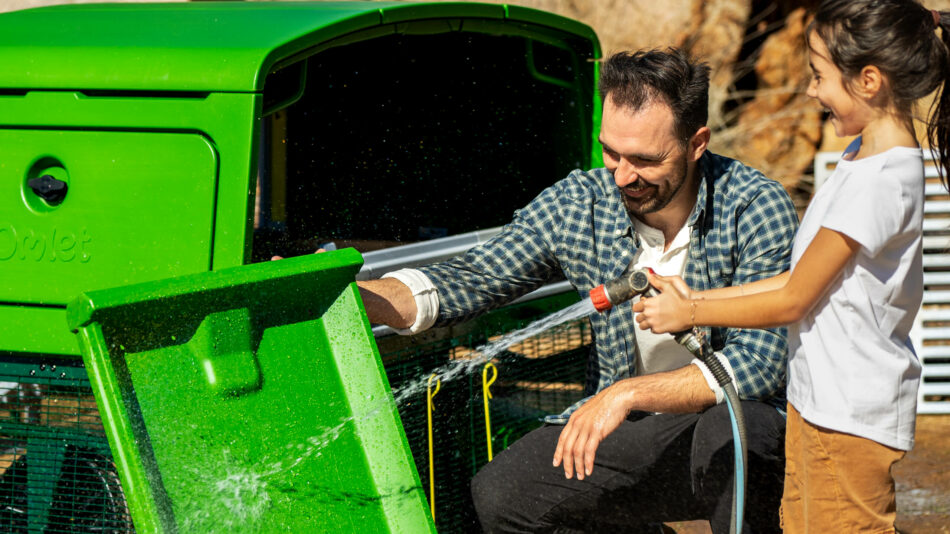
Why is plastic better than wood?
Chicken coops are traditionally made from wood. Why is this? It’s because wood is readily available, and is relatively inexpensive as a material. DIYers and homesteading families can make a chicken coop from wood in anywhere from a few hours to a few days. But that’s about where the pros list ends. Reasons to avoid a wooden chicken coop are numerous, with the main drawbacks to wood being:
- Rot and mold or mildew
- Difficult to clean
- Costly and routine maintenance
- Vulnerability to predators
- Not waterproof
- Short lifespan
- Ideal environment for mites
- Difficult to move
- Flimsy
Plastic on the other hand, poses opposite benefits where wood finds itself falling short. Plastic chicken coops:
- Won’t rot or warp
- Are easy to clean
- Don’t require regular maintenance
- Provide superior protection against predators
- Are waterproof
- Have a lifespan of 20+ years
- Won’t harbor mites
- Can be moved easily
- Hold up in the elements
But among these, there are a few standout reasons that reveal a clear winner when comparing plastic vs wooden chicken coops.
Insulation
When you keep chickens, protecting them against the elements will be unavoidable — and insulation plays a vital role in keeping your chickens healthy and comfortable in all conditions. Insulation helps keep the inside of the coop at a comfortable temperature by trapping a pocket of air between the coop walls. In the wintertime, this means your hens’ body heat will be kept inside, while the cold outdoor air is kept out. And in the summer months, insulation protects against the outdoor heat, preventing the coop from becoming a hot box.
Wooden chicken coops can’t be insulated properly, unless they’re built in a fashion similar to modern homes. But wooden coops readily available for purchase will not be insulated, and carry a high likelihood of developing dangerous drafts. Omlet’s chicken coops are insulated and draft-free, while providing ample ventilation to promote healthy respiratory function within your flock.
Predator protection
Aside from the elements, another challenge flock raisers face are chicken predators. Even backyard flocks aren’t immune to threats. Wooden chicken coops warp and weaken in the elements, making them susceptible to predator invasions. And, the latches on wooden chicken coop doors are easy for predators like raccoons to riddle out.
Omlet’s plastic chicken coops are strong enough to withstand predators as large as bears and as lithe as weasels. Our raccoon-proof chicken coop door handles and tight run wire spacing keeps predatory paws at bay, while the added security of an automatic chicken coop door makes it nearly impossible for opponents to open. And, the anti-tunnel skirting of the attached run will foil foxes and deter dogs from digging into your hens’ home.
Cost of maintaining
If the idea of re-roofing, sealing, and painting a chicken coop every year sounds appealing to you, then a wooden coop will gladly demand your time and resources. But if you’re like the majority of other chicken keepers, you’ll find the prospect of this necessary wooden coop upkeep a dreaded task. While acquiring a wooden coop requires less initial investment than a plastic coop, the ongoing expenses of maintaining it each year make it a costly endeavor.
Plastic chicken coops don’t require regular maintenance, and will never need re-roofing, painting, or sealing. They’re waterproof, weatherproof, and maintain their appearance and performance throughout the years.
Ease of cleaning
Cleaning a wooden chicken coop is a chore, and an unpleasant one at that. But thanks to plastic, chicken coops can be cleaned in a fraction of the time and elbow grease. No more scraping roosting bars and coop floors or dusting surfaces with coop refreshers or mite repellents — with a plastic coop, you can keep your hens’ home hygienic and healthy with minimal effort.
Cleaning an Omlet chicken coop is fun, efficient, and yields a sparkling clean coop for your flock in just minutes. Simply slide out the droppings tray, dump the soiled bedding, and use a pressure washer or garden hose to spray any debris away on the inside of the coop. Dry with a clean towel, refill the tray with bedding, and reassemble the coop. And just like that, your chicken coop is clean.
Omlet and your flock
We aren’t just biased in our belief in the super powers of plastic — thousands of real-life testimonials all agree that Eglu Chicken Coops are the future of chicken keeping. And with smart accessories like the Autodoor and Coop Light, you can future-proof your flock and revolutionize your routine. So, if you’re ready to break up with your wooden coop and embark on the path of plastic — we’re here for it.
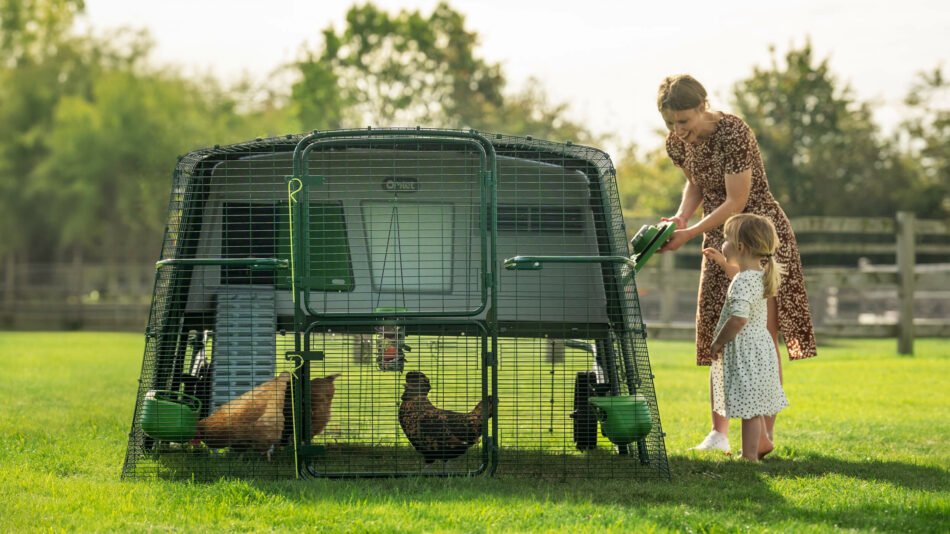

This entry was posted in Chickens
It’s the most pivotal time of the year again — chickens are soaking in the last rays of summer sunshine while brisk evenings become more common. With this transitional time taking place over the course of several weeks, it’s the perfect time to begin preparing your chicken coop for the changing seasons. Learn how to help your flock acclimate to the weather and temperature changes by making some adjustments to their coop and run.
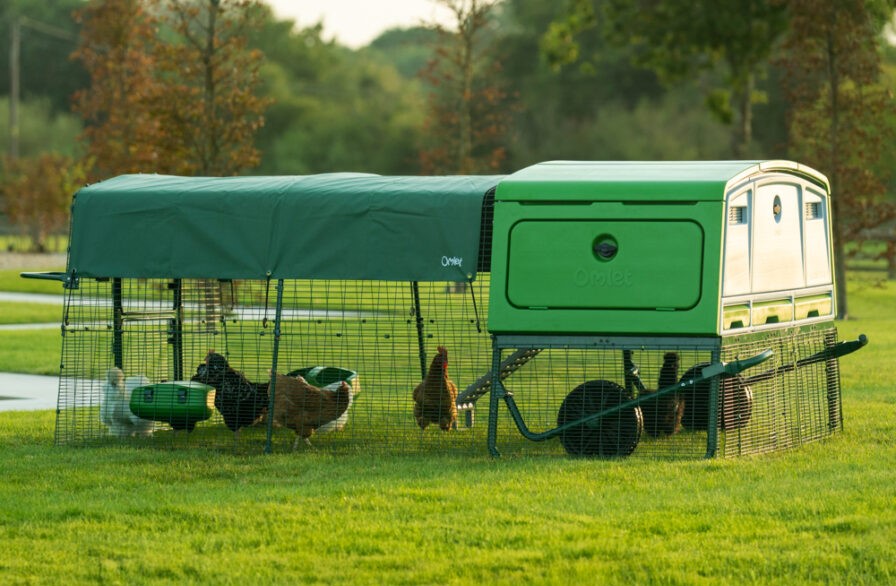
Coop considerations
To help prepare your hens for the cooler temperatures, there are a few things you can do to their chicken coop and run to support them through this season of change. From special cleaning sessions to preparing for wild weather, here’s your fall chicken-keeping checklist.
Deep cleaning
You should give your chicken coop a thorough cleaning at least twice a year: in the spring, and in the fall. By giving your coop a deep clean, you’ll ensure that your flock goes into the new season with a crisp, clean home to support a healthy immune system. Spot cleanings and bedding changes should be carried out weekly, but this seasonal deep cleaning should involve taking out all removable components of your coop to thoroughly pressure wash or scrub clean.
Bedding refresh
To prepare for the chillier evenings and soon to be frigid nights, you’ll want to change your flock’s bedding from pellets or recycled paper to wood shavings or straw. Shavings and straw have better insulating properties, which helps retain heat within the coop. Omlet’s Eglu Chicken Coops have twin-wall insulation to help retain heat, with ample ventilation to prevent moisture buildup. The Eglu Pro has the added benefit of adjustable vents to allow less air in during the colder months.
Change your clocks — and batteries
Changing your clocks soon? Then it’s time to check the batteries in your Smart Autodoor and adjust the time settings. Change the batteries if needed, and adjust the schedule accordingly to accommodate for the shorter days, If your Smart Autodoor is programmed to open and close with the amount of daylight, then you’re all set for the coming season.
Cover those feathers
Weather covers for chicken runs will help keep cold condensation off of your chickens. Chickens handle the cold quite well, but only as long as they’re able to stay dry. Wet feathers can quickly spell hypothermia during cold weather, and muddy runs can cause bumblefoot or other bacterial infections in your flock. Opt for transparent run covers during the frigid weather to allow sunlight to warm your flock while protecting them from the wetter weather.
Weather the storms
Fall is notorious for its wild weather patterns. Depending on where you live, the only predictable part of fall weather is that it’s unpredictable. Make sure your chicken coop is outfitted with wheels and handles for quick, easy movement in preparation for severe weather events. You’ll also need to check your coop after each storm to assess it for damage. Eglu chicken coops are designed to be weatherproof, giving you a warp and worry-free outlook on severe weather.
Warm up the water
Once the weather dips below freezing, your chickens’ water will begin to freeze. Keep your chicken waterers in sunlight to help them stay thawed during the day, and break the ice as needed. Bird bath heaters can be submerged in chicken waterers to keep them thawed, or you can keep your flock’s water from freezing over by adding boiling water to their container several times a day.
Seasonal specifics
As fall settles in, your flock will start experience natural, biological changes. The dwindling daylight hours is a signal for them to shed their old feathers in favor of new ones, and egg laying will become less frequent. See what other fall-specific activities your flock will be up to this season.
The messy business of molting
Chickens molt annually during the fall. This process involves your chickens shedding all of their feathers in order to regrow them in preparation for the winter. Because this event takes immense amounts of energy, your hens will lay fewer eggs or stop laying altogether. Chickens will usually complete a molt within 4-12 weeks. To help your hens through a molt, offer them plenty of protein in the form of dried insects, or rich hay like alfalfa.
Wood ash for better dust baths
One of the best additions to your chickens’ dust bath is ash from burned wood or leaves. Utilize the remnants of your autumn bonfires in your chickens’ dust bathing area by sprinkling or pouring them directly into the basin or designated spot. Make sure the ash isn’t from fires that contained treated wood or other chemicals, as this can cause harm to your chickens. Natural tree branches, leaves, or untreated logs for a fire make perfect ashes that your hens will revel in.
Omlet and your flock
Fall is an incredible time to spend with your flock. Make sure they’re fully supported throughout this season and the ones to come with insulated chicken coops, a Smart Autodoor, and chicken run covers. With Omlet, you and your flock can approach the changing seasons with anticipation rather than apprehension.
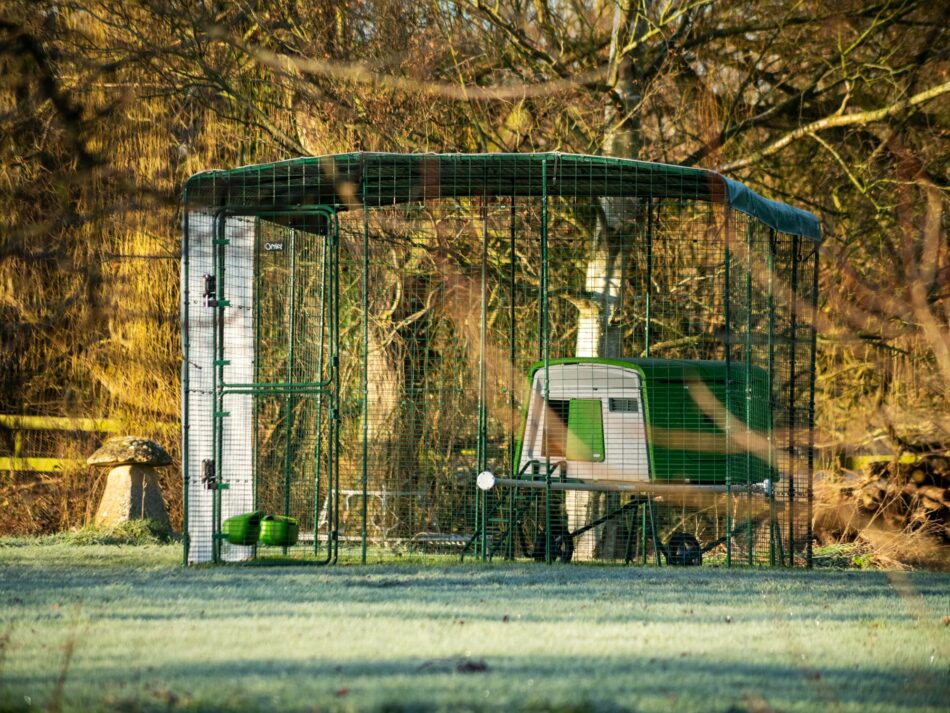

This entry was posted in Chickens

The right chicken coop size is crucial for every flock. Your hens’ home will need to safely and comfortably house them, and you’ll want to ensure that you have the correct size to accommodate your chickens. Appeal to all of the Goldilocks in your flock with our tips and coop sizing. Find the perfect coop size that’s not too big, not too small but just right.
The importance of the right chicken coop size
Chicken coop size is important because hens need adequate space to roost at night and lay their eggs. Chicken coops with dedicated egg-laying areas are ideal so that your hens have a place to rest and a place to nest. This keeps your eggs clean and free from being smashed by roosting chickens.
Your chickens’ coop should be large enough for your hens to feel comfortable and safe. Keep in mind that your hens’ house will mainly be used to sleep in at night and to lay eggs. Your hens will play, forage and be active outdoors, so their coop will only need to be large enough to maneuver into roosting or laying positions comfortably.
It’s also important to not get a coop that’s too large – especially in colder climates. Hens huddle together during chilly weather, and a smaller coop will help contain their body heat within. If you know that you’re limited to keeping 3 or 4 hens, it’s best to go with a smaller chicken coop. But if you plan to keep more than 4 hens, their body heat will fill the space of a larger chicken coop. To get you started, check out our backyard chicken coop and care guide.
How much space is needed per chicken?
There’s no exact formula for determining how much space to give chickens, and chicken coop sizes can vary.
Chicken Math
The phenomenon “chicken math” plagues most chicken keepers when trying to calculate coop size per chicken.
This is a term used when flock raisers acquire more chickens than they originally intended to. So, it’s always a good idea to get the biggest chicken coop you can for your space, should chicken math creep up on you.
As a general rule, you’ll want to provide your hens with as much space as possible. This will allow ample space for your existing flock, as well as room to grow.
Breeds
Different breeds of chickens have varying space requirements, and each individual hen will have their own opinion of how close they prefer to be during roosting.
Some breeds are larger than others so naturally a large chicken coop might be more beneficial to begin with – you can always add more coops in the future!
City or State Law
Some cities or states may require specific dimensions for your chicken coop based on the number of hens you have. Check with your city’s zoning department to see if there are chicken coop size requirements or restrictions before choosing your hen house.
What to consider when deciding the perfect size chicken coop?
The Essentials
Before settling on your chicken coop size, make sure you consider the following:
Coop Location
You’ll also want to consider if you want a mobile chicken coop or one that you’ll keep in a permanent location. Portable chicken coops are great for letting your chickens help mow your lawn, and are particularly helpful in areas that experience severe weather events. They can be moved to safety quickly and easily – while your flock remains safely inside.
Chicken coops placed in a permanent location will need a chicken run or chicken fencing to be attached to or placed inside. This will allow your hens time outside of their house in safety, and keep them from areas you’d rather not have them pecking around in.
First Time Chicken Keeping
Ultimately, choosing your chicken coop comes down to personal preference. Our beginner chicken coops are perfect for those starting out on their hen journey as they are easy to clean and maintain. Most chicken keepers would agree these are at the top of their list when it comes to selecting a chicken coop. At the end of the day, your ideal chicken coop size should be one that fits your needs and fits your flock inside.

How to find the right chicken coop size for your flock
If you’ve already decided on which breeds of chickens you’re going to keep, it’s time to determine how many you want to have. If your city or HOA has restrictions on how many hens you can have at any given time, then your decision is made for you.
There are still many different types and sizes of chicken coops to consider. Those with these restrictions can easily choose from our chicken coops for 2-4 chickens:
The Eglu Go
- Perfect for those needing a low-profile chicken coop
- Ideal coop that keep hens that prefer roosting at ground level
- Can also be used as additional housing for sick or injured hens
- Coop size dimensions: L = 9ft 6in, W = 5ft 5in, H = 2ft 7.5in (measurements include run)
The Eglu Go Up
- Ideal for those wanting an elevated coop
- Can be converted into a mobile chicken coop easily with the addition of handles and wheels
- Coop size dimensions: L = 7ft 2in, W = 4ft 9in, H = 3ft 8in (measurements include elevation above ground level)
The Eglu Cube
Larger flocks can be housed comfortably in one of our large chicken coops. The Eglu Cube is recommended for:
- Flocks of up to 10 small breed chickens
- Chicken keepers wanting to grow their flocks
- Both mobile and permanent setups
- Coop size dimensions: L = 7ft 7in, W = 5ft 1in, H = 3ft 10in (can be extended to 12ft with runs)
How to increase the size of your current chicken coop
At Omlet, we have firsthand experience with chicken math. Expanding your flock’s space will likely be an ongoing endeavor. After all, unless your city or HOA says otherwise, you can never have too many chickens.
Our walk in chicken runs can be extended indefinitely to accommodate your growing flock.
- Simply choose your ideal dimensions using our online configurator.
- Attach the corresponding run extension to your existing walk in run.
- Our attached chicken coop runs can also be extended to up to 12 feet.
- Place your order!
You may also wish to add extra chicken coops for sleeping and laying space within your growing run. The addition of any of our Eglu chicken coops will offer lodging to your growing flock. Create different areas of your chickens’ area with chicken run partitions, which can separate your flock by breed, size, or temperament. Our chicken coop ideas might help you settle on your next steps.
First-time chicken-keeping tips
Ready to get started keeping chickens? Once you’ve determined your coop size, here are some other things to check off before making the poultry plunge:
- Research what type of diet you will feed your hens. This could be regular laying feed, organic, non-GMO, or free-range pellets or crumbles.
- Decide if you want to start out with hens or chicks. There are pros and cons to each, but chicks will require additional equipment and care for the first 6-12 weeks of their lives.
- Prepare your yard and measure where you want your chicken flock’s home to be. This can help you determine if you would prefer a mobile or permanent setup.
The perfect size with Omlet
Choosing the chicken coop size that’s right for you is a big decision. But with Omlet, you can be sure that no matter the size of the coop, you’ll be getting a hen house or chicken tractor that’s been designed to last a lifetime. All of our chicken coops are built from the same heavy-duty, rot-free materials. Along with accessories to help your flock enjoy their space to the fullest.


This entry was posted in Chickens
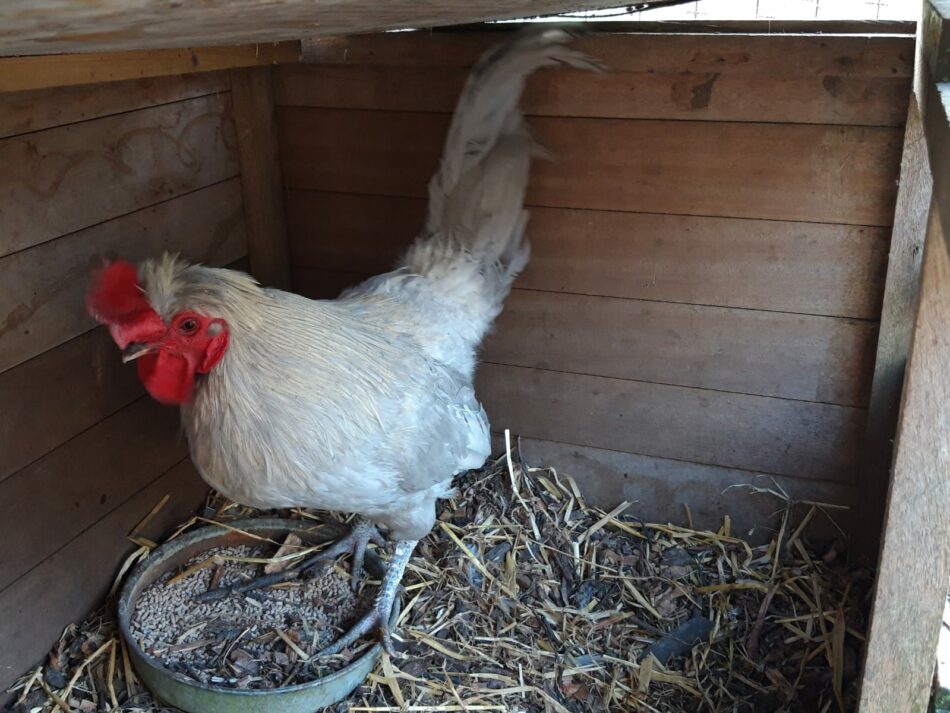
Wooden chicken coops have historically been the most common type of hen houses – but there are several reasons to avoid wooden chicken coops. Many types of wood are inexpensive and help lower the cost of a chicken coop. But, lower costs also mean lower quality. Over time, these cheaply made hen houses need replacing, which in turn costs you more money over the years. Thankfully, there’s an alternative to rickety, cheap, and hard-to-maintain wooden chicken coops. Don’t get caught in the vicious cycle of replacing worn-out wooden coops. Instead, invest in a plastic chicken coop that’s built to last a lifetime.
10 reasons to avoid wooden chicken coops
We’ve outlined the most common concerns when it comes to wooden chicken coops. And, when compared to plastic, there’s a clear winner.
1. Wooden chicken coops rot
Not all chicken coops are created to last. Wooden chicken coops, while less expensive to purchase initially, will eventually rot. Wood is a natural material that’s subject to the elements. Plastic chicken coops will never rot and don’t decompose the way wooden chicken coops do. Omlet’s chicken coops are designed to last a lifetime.
2. Wooden chicken coops are hard to clean
Have you ever scraped the inside of a wooden chicken coop with a putty knife or other flat-edged cleaning device? If you have, you’re not likely to forget it easily! And if you haven’t — you’ll want to spare yourself the experience. Removing droppings and thoroughly cleaning a wooden chicken coop is a very difficult task. Wood will rot faster if cleaned with a pressure washer, and takes hours to dry after getting wet.
Omlet’s plastic chicken coops are incredibly easy to clean. All of the interior pieces can be removed for easy cleaning, and the entire chicken coop is designed to be pressure washed or wiped clean. Get a sparkling clean chicken coop in just minutes with very little drying time.
3. Wooden chicken coops are costly to repair
Wooden chicken coops start to deteriorate as soon as they are exposed to the elements. Their roofs will need shingles replaced, as will rotted or warped boards. Chicken wire or hardware cloth will come loose from staples anchored in flimsy wood and will need to be reinforced. A lot of routine maintenance goes into keeping a wooden chicken coop structurally sound.
Plastic chicken coops require no maintenance or upkeep. Omlet’s chicken coops are easy to assemble, and don’t require replacement parts.
4. Wooden chicken coops aren’t predator-resistant
Chicken predators are something that all flock raisers will encounter at some point. One of the most common and conniving of these predators is raccoons. Wooden chicken coops are no match for the crafty methods of these masked chicken bandits. Raccoons are notorious for reaching through openings, and gnawing or pushing their way into hen houses and chicken runs.
While wood weakens over time, plastic chicken coops will hold up over the years — making them much more resilient. Raccoons in particular will exploit any weak spots in your chicken coop or run, so the best way to make your chicken coop raccoon-resistant is to invest in a strong setup.
Add another layer of security to your hens’ home with an automatic chicken coop door. Omlet’s Autodoor opens and closes on a horizontal spiral mechanism that is extremely difficult for predators to pry open. And, with the light and time settings, your flock will be safely closed in each evening before predators are at their most active.
The Autodoor is designed to integrate seamlessly with the Eglu Cube chicken coop, but can also be added onto any chicken run through one of our attachment kits.
5. Wooden chicken coops aren’t waterproof
Wood is porous and gets saturated when it rains. Not only does this lead to rotting, but it also creates breeding grounds for mold and mildew. Spores from these fungi can spell respiratory problems for your flock, and create very unpleasant living conditions.
Omlet’s coops are waterproof and won’t mold, mildew, or rot as a result of rain. And, additional chicken run weather protection will keep your flock stay nice and dry on rainy days in their run. Chickens can enjoy rainy days when they’re covered and have a dry coop to roost in.
6. Wooden chicken coops aren’t insulated
One of the biggest issues with wooden chicken coops is their lack of insulation. Drafty chicken coops can be deadly during winter storms, and downright scorching in the summer heat. Without insulation, your hens’ house will fluctuate wildly along with the weather.
Omlet uses twin-wall insulation methods in our chicken coops to ensure ultimate comfort. Our line of Eglu chicken coops help keep your hens cool in the summer and warm in the winter.
7. Wooden chicken coops have a short lifespan
Replacing your chickens’ coop every few years sounds like a costly endeavor, right? But it’s exactly what you’ll be doing with wooden chicken coops. The best chicken coops are designed to last a lifetime, and can grow with you and your flock.
Omlet’s chicken coops aren’t just long-lasting but have attached runs that can be extended to up to 12 feet long. They also integrate seamlessly with our heavy-duty walk in chicken runs, which can be extended indefinitely.
8. Wooden chicken coops let mites thrive
Mites are a nightmare for chicken keepers and hens alike. They make your flock feel miserable, and are hard to eradicate, as they thrive in moist, dark crevices. Mites are easier to prevent than to treat, and one of the best ways to avoid mites in the first place is to create an inhospitable environment for them.
Avoid mites by investing in a plastic chicken coop. Regular pressure washes or wipe-downs will prevent the presence of these parasites and give your flock a much more hygienic environment.
9. Wooden chicken coops are hard to move
There’s a sense of finality when you set a wooden chicken coop in its place. Once erected, a wooden coop cannot be moved easily. Whether it be from rot or weight from being rained on, wooden chicken coops are not meant to be relocated.
Some wooden chicken coops claim to be chicken tractors (mobile chicken coops), but due to their deterioration in the elements, they become increasingly difficult to move.
Our mobile chicken coops are designed to be moved as often as you’d like, and can be moved with ease by just one person. All of our coops can have wheels and handles added to make moving them a breeze. Their structural integrity holds up against the elements, so you’ll never need to worry about them falling apart.
10. Wooden chicken coops are flimsy
Wooden chicken coops are no match for wild weather events or large predators like bears or coyotes. During storms, roofs can be blown off and boards loosened by battering wind and rain. Predators can easily push through chicken wire or dig under runs.
Omlet’s Eglu Cube chicken coop is strong enough to withstand hurricanes, bear attacks and falling trees. And, all of our chicken runs are made from heavy-duty wire-welded panels that feature anti-dig skirting to help prevent predators from digging into your chickens’ space.
Omlet’s Eglu Cube chicken coop
The winner is clear: the Eglu Cube chicken coop, exclusively by Omlet. But don’t just take our word for it — see why thousands of chicken keepers across the globe trust the Eglu Cube with their flocks. Plus, the Eglu Cube is backed by our 10 year worry-free warranty, and a 180 day money back guarantee. When you choose the Eglu Cube, you’re investing in the only chicken coop you’ll ever need to buy.
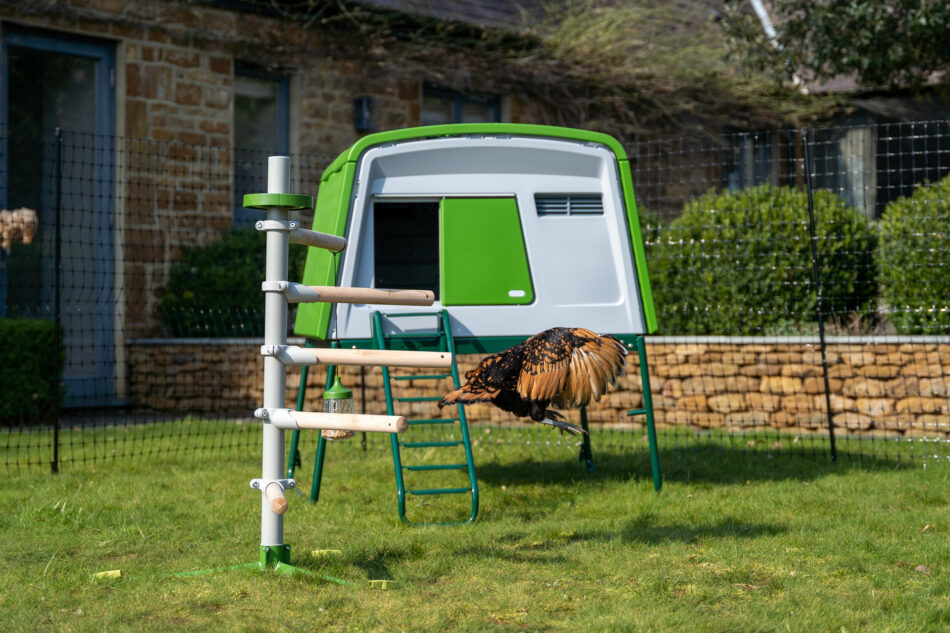
Omlet’s plastic chicken coops
Like all Omlet chicken coops, the Eglu Cube has been designed to outlast and outperform wooden chicken coops. With the addition of the Autodoor, your Eglu Cube will be a force to be reckoned with — deterring persistent predators, parasites, and perilous weather conditions. Invest in your flock’s future when you choose an Eglu Cube, and never worry about having to repair or replace your chickens’ coop.
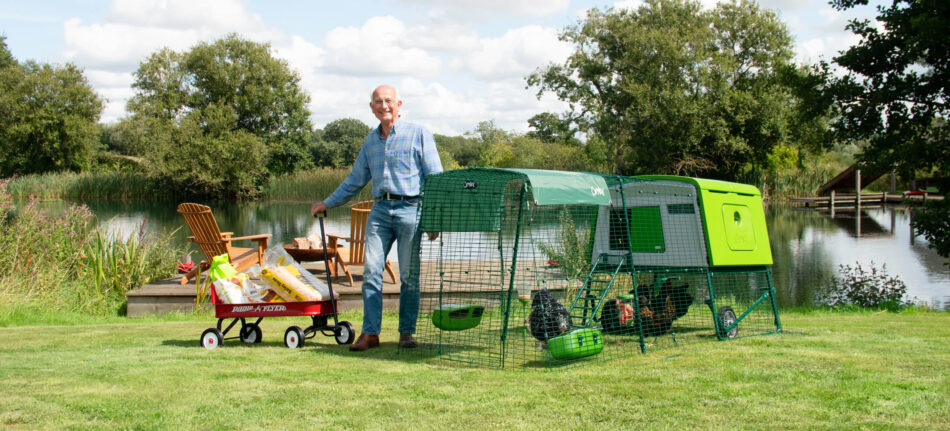

This entry was posted in Chickens
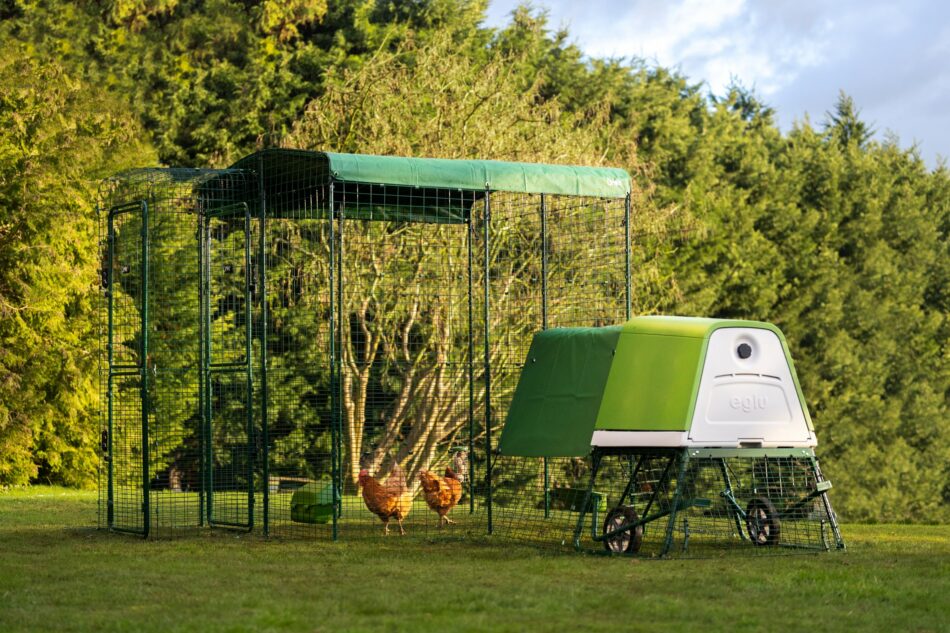
Looking for a beginner chicken coop? The best chicken coop for beginners are those that can grow along with flocks and their keepers – making it the first and last chicken coop you’ll need to buy. There’s a lot hinging on your hens’ home: their health, safety, and comfort. You’ll also want a coop that is easy and quick for you to clean, and is enjoyable to use. Omlet has the coops to check all of those boxes – and more.
The best Omlet chicken coops for beginners
The best chicken coops grow with their flocks and keepers’ level of experience. And, the best beginner chicken coops are easy to use from the start, but also functional and practical enough for even the most advanced chicken keeper.
We’ve made keeping chickens easy for all ages and stages of flock-raisers. Omlet’s line of Eglu chicken coops not only provide superior safety and comfort to the hens they house, but also allow owners to spend less time cleaning and worrying and more time enjoying their flock.
All of our coops are:
- Easy to build
- Simple to clean
- Predator resistant
- Have the ability to be mobile with the addition of our wheels and handles kit
- Are twin-wall insulated, keeping your flock comfortable all year round
Choosing your chicken coop depends on your space and how big of a flock you intend to keep. Once you’ve got an idea of where you want to place your coop and how many hens you want to have, you’re ready to find the coop that best fits your needs.
Types of chicken coops
There are a few choices to make when it comes to buying a beginner chicken coop. Some popular options are:
Each type of chicken coop has their own advantages, so you’ll need to decide which option best fits your lifestyle and space. For example, mobile chicken coops allow you to move your flock around your yard whenever you’d like. This lets your hens peck new grass and prevents a permanent spot from being worn into your lawn. Large chicken coops can house up to 10 small breed hens comfortably, and can also be converted into chicken tractors. Ground-level coops are best for chickens that don’t have a strong roosting drive, or for yards subject to height restrictions.
Wood vs plastic chicken coops
Above all, the best chicken coop for beginners is a plastic chicken coop. There are many reasons why plastic chicken coops are better than wooden chicken coops, as plastic is:
- Easier to clean
- Mite-resistant
- Rot-proof
- Better insulated
- Draft-free
- Easier to assemble
Purchase a plastic chicken coop at the beginning of your chicken-keeping journey, and it will serve you and your flock for years to come.
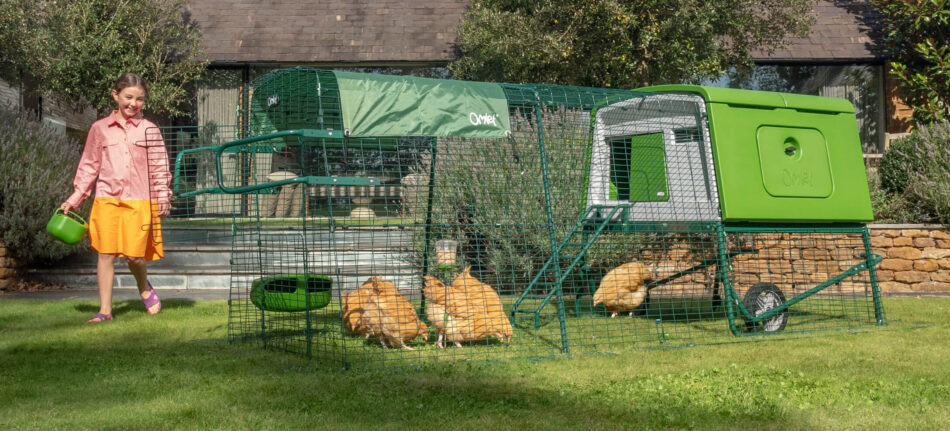
DIY vs ready-made chicken coops
Deciding whether to buy or build your first chicken coop? Building a proper chicken coop from scratch is hard – especially if you’re new to chickens. Hens have essentials when it comes to their home, and it’s hard for DIY plans to get them right. Most DIY plans look aesthetically pleasing, but leave much to be desired in functionality, safety, and practicality.
Omlet coops come as a kit to be assembled and have everything you need to get started with your flock right away. Our designs have been keeping hens healthy and happy for over a decade – so there’s no guesswork for you.
Choosing the perfect size coop for your flock
There’s a term that all chicken keepers will experience at some point: chicken math.
It’s used to describe the phenomenon of bringing home more chickens than you originally intended. This can occur right off the bat, or take a few months to set in, but at some point, most (if not all) chicken keepers crave more chickens.
That being said, it’s always best to get the biggest coop you can for your space and budget. Chickens thrive when as much space as possible is available to them, and extra space allows room for the inevitable chicken math conundrum.
What needs to be in your new chicken coop
A good chicken coop keeps hens comfortable, safe, and shielded from the elements – but a great chicken coop offers entertainment and enrichment as well. Chickens get bored if they don’t have enough stimulation, which can lead to behavioral and health issues. Be sure to offer a variety of things to keep your flock busy when they’re in their coop’s attached run. To bust boredom, try offering:
The more space and activities your hens have, the happier and healthier they’ll be. Some other ideas to keep boredom at bay include: serving fresh veggies in a Caddi Chicken Treat Holder, socializing with your flock, or moving a mobile chicken coop to fresh pecking grounds.
Top chicken coop care tips for new keepers
New chicken keepers should keep the following in mind when taking care of their chicken coops:
- Clean out your chickens’ coop daily to keep it fresh and to keep your hens’ in good health
- Use an odor-absorbing bedding such as pine pellets or shavings
- At least once a week, remove the roosting rack and droppings tray from your coop to pressure wash, or scrub with soap and water
- Collect eggs daily to help prevent broody hens and visits from predators
Keeping your chicken coop clean is one of the best ways to ensure that your hens are in a healthy atmosphere. Like most birds, chickens keep themselves clean through preening and dust bathing – but it’s up to their owners to keep up with their housekeeping.
Choosing a run your flock will love
Companion pieces to most chicken coops are chicken runs. Even if you want your hens to have access to most of your yard, there will inevitably be times that you’ll want to keep them penned up in a run. Large chicken runs give flocks that free-range feeling, without the hazards.
The best option for large spaces is a walk in chicken run. Not only does it maximize your chickens’ space, but it allows you to walk with your flock and get closer than ever to your hens. Omlet’s walk in chicken runs can also be extended at any time to accommodate a growing flock. Covers for walk in chicken runs can be added to give your flock shade from the sun or a barrier from snow, rain, and wind.
Other considerations when choosing your coop
Once you’ve researched and chosen the type of coop that best fits your lifestyle, you’ll also need to consider: chicken predators, the changing seasons, and zoning laws that may be applicable to you.
Predators
Omlet coops are designed to protect against chicken predators. The types of predators vary depending on your location, and you can bet that at some point they will come after your hens. Common chicken predators include:
- Raccoons
- Hawks
- Coyotes
- Foxes
- Snakes
- Neighborhood cats and dogs
Adding an automatic chicken coop door to your chickens’ coop adds an extra layer of protection against predators. The Autodoor ensures that your flock is safely closed into their coop each night, and the horizontal opening mechanism makes it extremely difficult for predators to pry open.
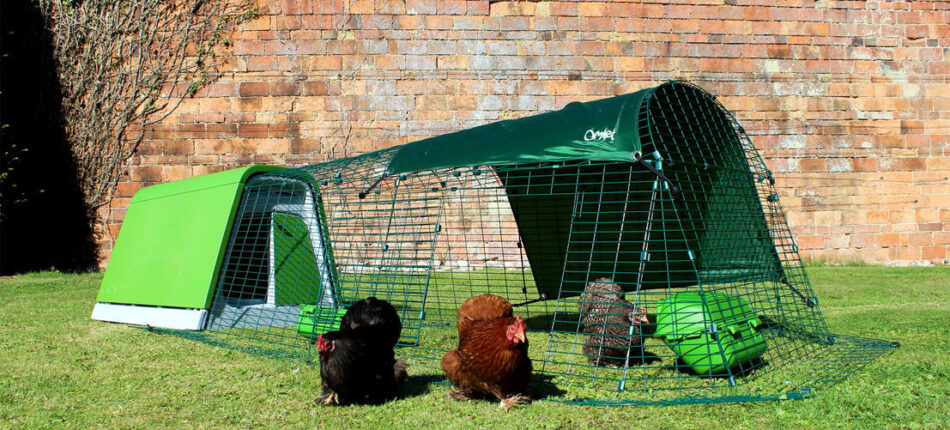
Seasons
Chickens are amazingly resilient, being built for life outdoors. However, not all breeds fare well in extreme temperatures. That’s why it’s so important to choose breeds that are suited to your location’s climate. Cold hardy breeds typically don’t fare well in the heat, while heat-tolerant breeds may struggle in the bitter cold. Aging hens may also not weather the changing seasons as they once did, and some minor coop modifications can go a long way in helping them through the extreme temperatures.
For areas that experience prolonged sub-freezing temperatures, an extreme temperature jacket can be added to your chickens’ coop as an extra layer of insulation. Weather protection for attached chicken runs in the form of tarps and covers can also be added to keep snow, rain, and wind off of your hens.
The same tarps and covers can also be used for hot weather conditions by providing shade on scorching days. Hens often do well in warm weather as long as they have adequate shade and water. You can also offer your hens frozen treats such as corn to help cool them off.
Zoning laws
Most states allow individual cities to decide if they will allow its citizens to keep chickens in their backyards. Many urban areas allow chickens, but you’ll need to contact your city’s zoning office to make sure before taking the plunge into poultry ownership. Homeowners associations (HOAs) may also have additional rules and regulations regarding chickens.
Zoning laws regarding chickens will often pertain to:
- How many chickens you can keep
- The size, type, and location of your chickens’ coop
- Roosters
HOA bylaws may differ from the city you live in. So, if you’re subject to an HOA, make sure you check with both the city and the HOA you reside in before purchasing your chicken coop.
Keeping chickens for the first time
Getting chickens for the first time is an exciting experience. But don’t forget that preparation goes a long way when getting ready to bring your flock home. Make sure you have the time, space, and supplies for your hens before committing to being a flock’s forever home. Some additional things to consider when keeping chickens:
- A safe, comfortable chicken coop
- Chicken run
- Perches
- Food
- Feeders and waterers
Make sure all of your equipment is assembled, and familiarize yourself with it before introducing your flock. You may find yourself wanting to make minor adjustments such as moving feeders and waterers or perches around, but the majority of your chickens’ set up should be well established by the time your hens come home.
Your first and last chicken coop with Omlet
Choosing your chicken coop is a commitment, but when the creators of the coop are as committed to chickens and their keepers as Omlet, you’re sure to have the best experience possible. And, don’t forget to have fun with your flock. Accessories for your chickens take flock-keeping to the next level, and chicken treats help you quickly bond with your hens.
When you choose Omlet for your chickens’ coop and accessories, you’re not just purchasing your first coop – it’s the only coop you’ll ever have to buy. Unless of course you fall victim to chicken math and need more chicken coops. Don’t say we didn’t warn you!


This entry was posted in Chickens
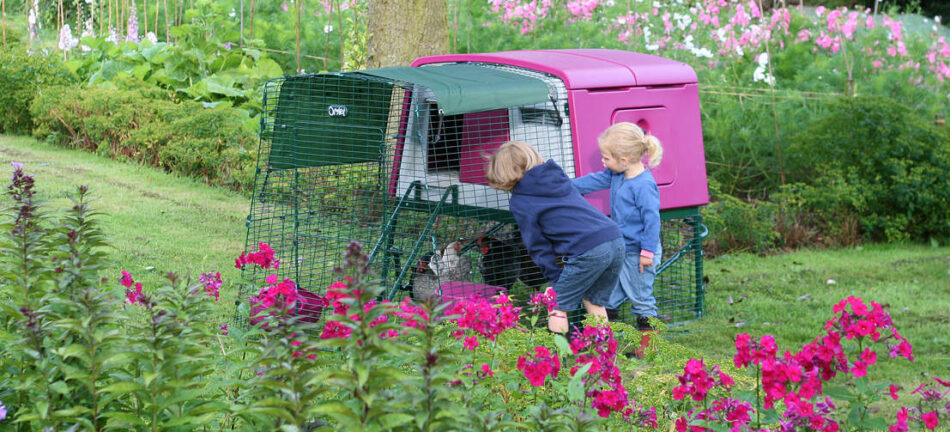
There’s a new dilemma that chicken keepers are faced with: whether to invest in a plastic or wooden chicken coop. Wooden chicken coops are common, but plastic coops are rising in popularity due to their low maintenance and ease of cleaning. Maintaining and cleaning wooden chicken coops is costly and time-consuming – but Omlet’s plastic chicken coops are saving chicken keepers both time and money.
Comparing wooden vs. plastic chicken coops
There are some major differences between wooden and plastic chicken coops. Ultimately, it comes down to which type of coop best fits your budget and lifestyle, but we’ll help you decide how to choose your chicken coop with a visual list of pros and cons for each.
Wooden chicken coops
Pros:
- Lower upfront costs
- Readily available at many chicken supply stores
- Traditional look
Cons:
- Difficult to clean thoroughly
- Absorbs moisture, which can lead to mold or mildew
- Porous, grooved surfaces attracts and harbors mites
- Drafty (particularly dangerous in the winter months)
- Requires maintenance such as repainting and roof or board repair and replacement
- Hardware cloth or chicken wire is stapled into the wood, which loosens over time, making it easier for predators to push their way in
- Difficult to move once in place

Pros:
- Easy to clean
- Waterproof
- Twin-insulated to keep your chickens cool in summer and warm in winter
- Draft-free ventilation that keeps humidity levels down inside the coop
- Inhospitable environment for mites to thrive
- Zero maintenance required
- Doors that are easy for humans to open, but difficult for predators to infiltrate
- Attached chicken runs are made from welded wire mesh connected by heavy-duty clips
- Bold, modern look
- Easily moved with added wheels and handles
- An all-in-one chicken coop, designed to last a lifetime
Cons:
Moving your coop
At some point, you may want to relocate your chicken coop. It may be to a new spot in your yard, out of necessity for safety, or when moving to a new home. Wooden chicken coops are difficult to move once they’ve been constructed, and often are too heavy to move efficiently without taking them apart. Commercially bought wooden coops are often constructed from tongue and groove planks, which do not hold up when moved.
Omlet’s mobile chicken coops can be moved easily by one person with the use of integrated handles and wheels. This is particularly helpful in areas that experience severe weather such as tornadoes, hurricanes, or flash flooding when notice is often in short supply.
Chicken tractors enable you to give your chickens a new patch of grass to forage through, or relocate your flock should the need arise. Simply engage the wheels, then use the handles to push or pull your hens’ home to a new spot. Disengage the wheels, and your hens are ready to peck their way through their new turf – without ever having to leave their run!
Customizing your chicken coop
Plastic chicken coops offer customization options that wooden chicken coops simply can’t. Additions of walk in chicken runs can expand your flock’s space and can continue to expand along with the number of chickens you have. You can also automate your chickens’ schedule by installing an automatic chicken coop door.
These accessories can be added to a wooden chicken coop, but the structural integrity of wooden coops becomes compromised after time in the elements, making them a less-than-perfect match. A plastic chicken coop designed to last a lifetime is not limited to a short timeframe for upgrades and customization.
Coop cleanliness
It’s important to regularly clean your chicken coop – no matter the material. Chickens themselves don’t smell, but their droppings do! Coops that aren’t clean attract flies and other pests that affect both you and your flock, and harbor bacteria that can bring harm to your flock.
Wooden coops need to be washed, but wood is porous and difficult to clean. Droppings usually need to be scraped off with a putty knife, with surfaces then sprayed with a chicken-safe disinfectant. Because wood absorbs moisture, you’ll need to allow ample drying time for any products or water applied to a wooden coop. Once dry, wooden coops need to be treated for mites after each cleaning with chicken-safe antiparasitic sprays or powders.
Plastic chicken coops can be deep cleaned quickly and easily. Omlet’s plastic chicken coops have removable roosting racks and droppings trays that can be pressure washed along with the entire interior. No antiparasitic treatment is needed after a plastic chicken coop has been pressure washed and wiped clean.
Predator resistance
Chicken predators are a danger that every flock raiser will encounter at some point. The sounds your hens make attract predators, as do the rodents that try to steal a snack from your chicken feeders. Even in urban backyards, chicken predators such as racoons and hawks can pray on your hens.
Wooden chicken coops usually have hardware cloth stapled around the inside of any openings. However, wood gets weaker the longer it stays in the elements, so the staples are easily pushed out of the wood from an outside force. Hardware cloth or chicken wire also rusts and weakens over time, making it prone to breaking under stress. Some wooden coops also have tops that open on hinges for you to access your hens or eggs. The problem is that predators (especially crafty ones like racoons or foxes) can lift any unlatched openings to access your hens themselves.
Omlet’s plastic hen houses have latching doors that are difficult for predators to open. They also have solid, heavy-duty walls with no wire to push in or break. Plastic is more resilient to the elements, so there’s no concern for warping or weakening over time. The attached chicken runs that are available with all of Omlet’s chicken coops are made of welded wire mesh that is treated against the elements. This heavy-duty wire does not weaken in the elements, with the panels being held together by our ingenious weather-resistant clips.
Insulation & performance in extreme weather
Chickens thrive in many environments, but the more assistance they get to regulate their temperatures, the better they weather the seasons. Heat stroke and frostbite can easily plague chickens that are kept in under-insulated coops. Depending on your climate, your main concern will be to either ensure your hens don’t get too hot in the summer or have chilly chickens in the winter.
Wooden coops need additional layers to offer sufficient insulation. Adding another wall with insulation in between can achieve this effect, taking care to allow for ventilation. Ventilation is key when keeping a chicken coop at a comfortable temperature and humidity level. Too much ventilation will allow insulated air to escape, making the coop too hot or too cold. On the other hand, too little ventilation causes moisture to build up, creating a damp, stuffy, overly warm coop.
Superior ventilation and insulation is found in Omlet’s plastic chicken coops. The twin walls trap a pocket of air (the best insulator) around the coop to help keep the temperature at a comfortable level. Mindfully placed ventilation points allow for just the right amount of air to circulate even when the coop door is closed. This reduces the humidity level in the coop and allows for fresh air to circulate.
Additional extreme weather protection for your hens can be added to Omlet chicken coops. This cold weather preparation for chickens helps your coop stay as warm as possible in the winter.

Durability – how long will a coop last?
The elements are not kind to wooden chicken coops. Harsh UV rays, soaking rains, heavy snow, and high winds all wreak havoc on traditional chicken coops. Wooden chicken coops maintain their integrity for the first few seasons, but soon you’ll notice the beginning stages of the deterioration process.
Rotting or weakening wood, faded paint, and missing roof shingles are usually the first elements of a wooden coop that fall prey to the weather. Replacing any weak planks and repainting or retreating boards with weather-resistant paint is an annual affair. Shingles can be reapplied to roofs, but it’s a sticky and time-consuming task!
Choosing a chicken coop that fits your budget is important, so keep in mind the long-term expenses that a wooden chicken coop will inevitably incur. A plastic chicken coop may cost more in the beginning but will save countless hours and dollars over the years, as they do not require maintenance.
Additionally, Omlet chicken coops are strong. So strong in fact, that real-life Omlet customers have shared stories of their coops surviving hurricanes, tornadoes, falling trees – and even the full weight of a bear! Heavy-duty plastic lasts for years, and you’ll never need to worry about rotting or weakening parts. The only maintenance needed on an Omlet chicken coop is regular cleaning and ensuring that the ground beneath the coop has not shifted to create gaps or misaligned doors.
Ease of building
Building a wooden chicken coop from scratch is a daunting task! Like any carpentry work, it must be squared off, level, and properly constructed. The supply list alone will have you making several trips to various hardware stores! How nice would it be to have everything come inside of a box, requiring only a screwdriver to assemble?
Deciding to buy or build a chicken coop relies heavily on your experience. Chicken coops (or any other animal enclosure) are not a project for beginners! Your flock’s comfort and safety depend on the design of their coop.
Thankfully, assembling an Omlet chicken coop can be done in just a few hours. Our step-by-step videos make assembly easy and enjoyable. All you’ll need is a level space and a screwdriver. Your children can even help build an Omlet coop, which will help include them in your family’s flock-raising journey.
Is a plastic or wooden chicken coop best for me & my flock?
Maybe you’re already the owner of a wooden chicken coop and thinking about upgrading to a plastic coop. Is it really worth all of the fuss? Check with your hens to see! Are your chickens happy in their wooden coop?
Unless you are meticulous with repairs and maintenance on a wooden chicken coop, your chickens would probably be happier in a plastic coop. The increased security, ventilation, insulation, and ease of cleaning that plastic coops have to offer make keeping chickens much more enjoyable. So ask yourself: are you happy with your chickens’ wooden coop? If the answer is “no”, then it’s time to upgrade to plastic!
Omlet’s easy maintenance plastic chicken coops
Omlet has a variety of high-quality plastic chicken coops to fit your flock and family’s needs. From the original Eglu Go, to our largest coop yet – the Eglu Cube, there’s a coop for everyone.
Reasons to choose a chicken coop from Omlet:
- Easy to clean, move, and customize
- Superior safety, insulation, and ventilation
- Weatherproof and predator-resistant
- Excellent customer service
- Backed by a 2-year warranty
Thousands of chicken keepers have experienced the ease of owning hens with an Omlet chicken coop. In fact, you can reach out to a local Omlet ambassador to ask them about their experience, and see their setup for yourself.
See the Omlet difference
We’ve invented coops that bring joy to chicken ownership. Keeping chickens shouldn’t be a chore – it should be a relaxing and rewarding hobby. Once you’ve decided on an Omlet chicken coop, explore our other products that are designed to complement to your coop, such as:
As always, our team of experts are ready to help you decide which coop is right for you and your flock, and to support your entire chicken-keeping journey.

This entry was posted in Chickens

Wondering what the benefits of a chicken tractor are? The term may or may not be familiar to you, but it’s one that chicken keepers across the US are researching more and more. You may also be wondering: what exactly is a chicken tractor?
Chicken tractors are great for adding diversity to your flock and your yard or garden. They also make it possible to move your hens quickly and safely, which is appealing to those that live in areas that experience severe weather events.
Omlet offers easy-to-assemble chicken tractors that are perfect for backyard flocks. Does the ability to move your flock appeal to you? Let’s take a look at chicken tractors, and how they can benefit flock raisers.
What is a chicken tractor?
Chicken tractors are floorless, mobile chicken coops, with or without wheels. The idea began when farmers wanted to raise meat chickens on pasture, but without the risks that free-ranging can bring. The result was the “chicken tractor”, so named because the animals contained within it churn the ground much like a tractor would. There are “tractors” for multiple species of farm animals, such as rabbits, poultry, and pigs. The effect was two-fold: pasture-raised animals produce higher quality meat than those raised in a barn or coop, and areas of dense vegetation could be mowed down by animals inside of the tractor.
This method has practical applications for backyard flock raisers that keep laying hens as well. Fresh grass, vegetation, and insects that hens ingest while foraging outside of their coop offer great nutritional value to their diet. In turn, some of these nutrients pass through to their eggs, making them healthier for you!
Reasons to get a chicken tractor
Aside from adding supplemental nutrition to your flock’s diet, keeping your flock in a chicken tractor has other benefits.
- Chicken tractors are easily moved, allowing you to relocate your coop whenever you’d like
- Mobile chicken coops can be moved in preparation for severe weather, changes in the seasons, or to help with landscaping
- Relocate your coop easily if you move, or if you have a small yard that would benefit from rotating your hens’ area
Chicken tractors for flocks of laying hens can be very practical, depending on your routine and space. A chicken tractor from Omlet can also be attached to chicken runs later for a more permanent chicken coop setup, making them a flexible and customizable option.
What’s the best chicken tractor for my hens?
Omlet chicken tractors come in different sizes and configurations. The Eglu Cube Chicken Coop configured as a mobile coop has an attached run with added wheels and handles. Our largest coop, the Eglu Cube is the best choice for larger flocks of 4 hens or more. Despite its ample size, the Eglu Cube chicken tractor can be moved easily by just one person. The raised coop offers extra pecking space below, as well as a shady area for your hens to get relief from the sun.
The Eglu Go Up Chicken Coop is a more compact version of the Eglu Cube. Best for flocks of up to 4 hens, the Eglu Go Up offers elevation to make coop cleaning and egg collecting easy. This smaller chicken tractor is perfect for children to help clean and move around.
Lastly, the Eglu Go Chicken Coop is a ground-level chicken coop that can be configured with handles and wheels to be converted into a chicken tractor. Some breeds of chickens (or individual hens) prefer roosting on the ground, making the Eglu Go an ideal choice.
What to expect the first time keeping chickens
- Lean into the first-time chicken-keeping angle, as many people looking at the benefits of a chicken tractor will be in the research phase before taking the leap.
- Consider presenting the types of thing people should expect from their first flock, and what they should have to be prepared for them.
How often to move your mobile coop
When to move your chicken tractor depends on a few factors. Chickens don’t just eat the bugs found in the grass – they actually eat the grass as well. The best method for deciding when to relocate your chicken coop is by observing the grass. Once your hens have mowed it down, it’s time to move to a new patch. It’s entirely possible to have your hens mow your entire yard by rotating them in a pattern.
It’s also helpful to move your mobile chicken coop to sunnier areas in the winter, or to shady areas in the summer. In the case of severe weather, a chicken tractor can also be moved quickly to a secondary shelter, or out from under trees to avoid potential falling limbs.
Can I move my tractor with the chickens inside?
Keeping your chickens inside your chicken tractor while moving it is dependent on their personalities and your terrain. Some hens may be content to go along for the ride when being relocated, while others may be alarmed. If your yard is relatively flat, the gap created along the bottom from engaging the wheels of the chicken tractor should not be large enough for hens to escape through. However, a panicked hen may attempt to squeeze through small spaces.
Test your flock’s reaction and build their confidence by moving your chicken tractor by just a few inches at a time. After some practice, you’ll likely be able to keep your hens inside while your mobile coop is being relocated. If your property isn’t flat, or if your flock is upset by being moved around, you’ll need to relocate your hens to a chicken pen during moves.
Tips to make your flock love their chicken tractor
Chicken tractors can be customized just like their stationary counterparts. Chicken toys and accessories or a chicken swing are perfect for adding height and enrichment to your hens’ environment. Simply add these entertaining pieces to the attached run of your chicken tractor, and enjoy watching your hens peck the ground and play in their personalized space.
Freedom with Omlet
Omlet believes in letting chickens live their best, most natural lives while being protected. Our chicken tractors have all of the features of our stationary coops, with the added convenience of being mobile. Flexibility in chicken keeping has never been easier than with Omlet’s mobile chicken coops. Combine our chicken tractor with chicken fencing to create custom boundaries for your chickens, and add chicken treats to your routine to deepen the bond between you and your flock.
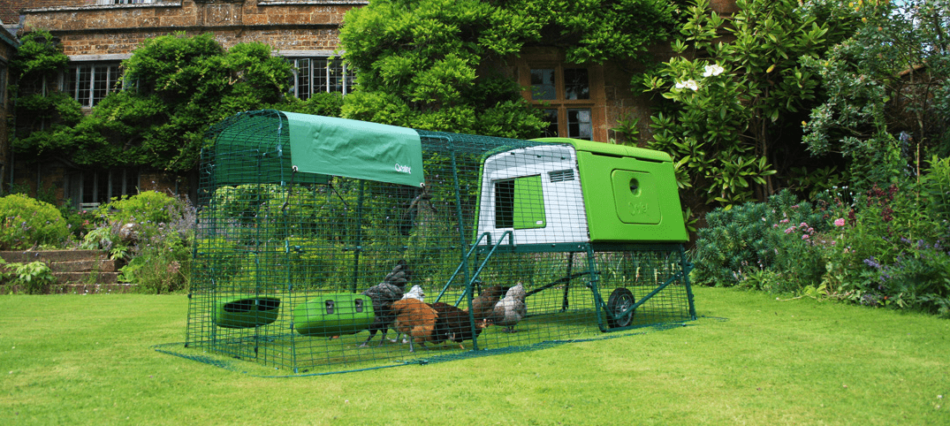
This entry was posted in Chickens
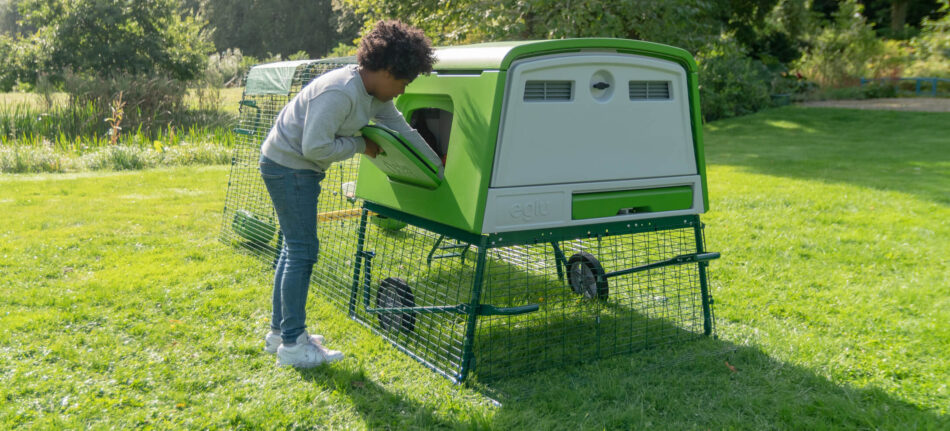
The best chicken coop is safe, functional, and comfortable for the hens they house, and easy to clean and maintain for their keepers. In short, the best chicken coops are those that bring joy to flock raisers, and ensure their inhabitants are healthy and safe.
But not all chicken coops are created equally. A high-quality coop may require some investment upfront, but will more than make up for it in the long run. At Omlet, we are simplifying the process down to comparison of quality and features, so you’ll be ready to make the right choice.
How to choose your chicken coop
When searching for the best chicken coop, size matters! First and foremost, you’ll want to decide on what size flock you want to keep to determine which chicken coop will meet your needs. For most chicken keepers, a small number usually evolves into more hens than originally planned (a phenomenon known as “chicken math” to those in the poultry world). By getting the largest coop within your budget, you’ll allow room for a potentially growing flock.
We advise you to check the zoning laws and ordinances in your State before purchasing chickens or looking to expand your flock.
Do I need a run?
Next, you’ll need to decide if you need a chicken run attached to your coop. Providing the most outdoor space possible will make your hens the happiest, regardless of your flock size. Runs that come standard with some coops usually aren’t large enough to provide that free-range feeling. But, not all chicken keepers are able to give their hens free rein of their yards either. Attaching a walk in chicken run to your chicken coop will offer plenty of space for your flock to forage and flourish.
Material
Finally, you’ll want to fully weigh the pros and cons of the material of your chickens’ coop. Traditionally, chicken coops are made out of wood, but many chicken keepers are making the switch to plastic chicken coops. There are many reasons for this, but one of the biggest deciding factors influencing this change is the longevity of plastic over wood.
What is the best chicken coop made from? Plastic vs Wooden
Plastic chicken coops, such as those designed by Omlet, do not require seasonal maintenance. The advantages of plastic over wooden coops are staggering, and can save chicken keepers countless hours and dollars over the years.
The advantages of plastic coops include:
Plastic coops also offer a less-hospitable environment for mites, which thrive in wooden coops. Mites take shelter in the grooves and crevices of wood, and flourish in damp, porous surfaces. Regularly cleaning a plastic chicken coop is the best and easiest way to keep mites at bay.
One of the biggest mistakes new chicken keepers make is not factoring in the maintenance required to keep wooden chicken coops safe and functional for their flocks. Even weather-treated wood warps and rots in the elements over time, which causes the structural integrity of the coop to be compromised. Roofs need replacing, paint needs reapplications, and the drafts resulting from shifting or settling require attention. Depending on the amount invested in the original coop, sometimes it’s more cost-effective to replace the entire coop rather than to mend seasonal issues.
Best chicken coop for large flocks (5 – 10 chickens)
Omlet’s largest chicken coop, the Eglu Cube can accommodate flocks of up to 10 small breed hens. Larger breeds of hens or larger flocks thrive in this size coop because of the:
- Spacious roosting area inside
- Partitioned nesting area
- Shaded area beneath the coop.
- Wide roosting rack to accommodate hens of all sizes
- Twin-wall insulation
- Draft-free ventilation
- Heavy-duty plastic construction
Most hens don’t mind sharing a nest with other hens, but after the 5th or 6th visitor to the same nesting spot, hens may seek out alternate laying locations. The expanded nesting area of the Eglu Cube factors in picky hens, giving them ample space to fluff up a new spot to lay in.
WHAT DO OUR AMBASSADORS SAY?
The Omlet Ambassadors are customers turned product and chicken keeping experts.
They can answer questions on the Eglu Cube and share their experiences of their Omlet journey and how they use our coops with their hens. You can find an ambassador near you to get the answers that matter most to you and your flock.
Best chicken coops for smaller flocks (2 – 4 chickens)
Perhaps you live in an area that limits the number of chickens you can keep, Or, maybe you’re just getting started with chickens and are hesitant to get too many hens at once. If so, Omlet has the best chicken coops for you too!
The Eglu Go Chicken Coop is a compact, ground-level coop that is the perfect size for small flocks of 4 hens or less. This coop is a great option for:
- Small-breed hens
- Chicks 12 weeks or older
- Chickens that prefer to roost on the ground.
- Secondary hen house and nesting area for growing flocks or injured hens
If an elevated coop still appeals to you, the Eglu Go Up Coop is the raised version of the Eglu Go. The added height allows for easier coop cleaning and egg collecting, and offers additional space beneath the coop.
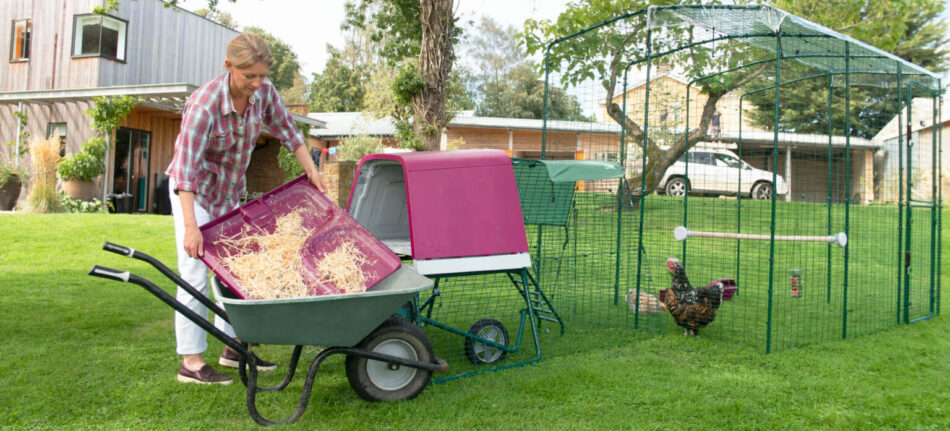
Best portable coop
Chicken tractors offer the freedom of flexibility for chicken keepers and their flocks. Chicken tractors are portable chicken coops that can be:
- Relocated easily for chickens to have access to fresh pecking grounds
- Mobile chicken coops that can be moved quickly and easily
- Beneficial to those in areas that experience severe weather events
Omlet’s chicken tractors can be moved effortlessly by one person. Simply engage the wheels and use the handles to roll your large flock’s home to a different location. Once the coop is in place, disengage the wheels and watch as your flock gets busy pecking around in their fresh patch of vegetation.
Just because they’re mobile doesn’t mean we’ve skimped on features – Omlet’s portable chicken coops have the same ingenious features as their stationary counterparts. Broad roosting racks, designated nesting areas, and heavy-duty construction are core components of all of our chicken tractors.
Best coop with attached run
An attached run offers additional space for chickens that may not have a safe area outside of their coop. All Omlet chicken coops can be customized with attached runs of varying lengths, which can also be moved along with mobile coops. Large flocks can enjoy up to 12 feet of attached run space when combined with the Eglu Cube.
However, the best chicken coop option that offers the most space for your flock is a walk in chicken run. Connection kits make integrating your Omlet coop or attached run quick and easy, or simply place the entire coop within the walk in run. Omlet walk in runs make it easier than ever to spend time with your flock, and maximize your chickens’ outdoor space.
Best budget coop
In terms of price, the Eglu Go Coop is the most budget-friendly chicken coop from Omlet. When compared to similar sized wooden chicken coops, its price point is slightly higher. However, cheaper, wooden coops will need routine maintenance, up to and including full replacement over time, whereas the Eglu Go does not require the same upkeep.
It’s also worth noting the quality of the attached runs. Wooden chicken coops weaken in the elements, causing chicken wire to come loose. Most wooden chicken coops use staples to affix mesh to the run, but when the wood rots, these staples are easily pulled out – leaving your chickens vulnerable to predators. Omlet’s attached wire runs are heavy-duty, and are held together by our innovative clips that won’t rot. Depending on the method of galvanization, chicken wire can bend and break under force from predators, giving them access to your hens and their eggs.
Easiest coop to clean
Keeping your Omlet chicken coop clean is immensely easier than cleaning a wooden coop. All components of the interior of Eglu chicken coops can be removed and thoroughly cleaned in minutes, and the entire coop can be pressure washed for a deep clean. Omlet’s best chicken coops are portable and can be moved closer to designated cleaning areas for even easier access.
Routine cleaning and disinfecting is important for your hens’ health. Mites and other parasites that commonly seek out chickens live in damp, porous surfaces that are left alone. Wooden chicken coops are often breeding grounds for mites if not treated with insecticides– which in turn can irritate your hens. The best method to control mites is preventing them from taking hold. Plastic coops are not ideal environments for parasites, and daily cleaning will virtually eliminate their presence.
Best hen house for collecting eggs
A raised chicken coop is the easiest type of coop to gather eggs from. The Eglu Cube has a separate door that opens to the nesting area, giving you quick and easy access to fresh eggs. Children especially will enjoy how easy it is for them to participate in this favorite activity among chicken keepers.
Eggs can stay in the chicken coop for several days and still be fresh, but collecting eggs daily is always the best practice. Daily egg collection removes temptation for predators, gives your hens room to lay the following day, and gives you a chance to evaluate your hens’ health. And, as you’ll soon learn, there’s nothing quite like collecting a still-warm egg from the nesting box, laid by one of your own hens!
Chicken coop essentials
Once you’ve found the best chicken coop for your hens, there are optional accessories you can add to make your backyard keeping experience even more enjoyable – for both you and your flock:
Award-winning chicken coops from Omlet
Omlet has been in the business of creating the best chicken coops on the market for decades. Our hen houses, chicken pens, and line of chicken toys add joy to the lives of flock raisers, helping them keep their chickens happy and healthy. If you have questions about our chicken products, feel free to reach out to one of our experts at Omlet, and we would be happy to assist you in beginning your chicken-keeping journey.
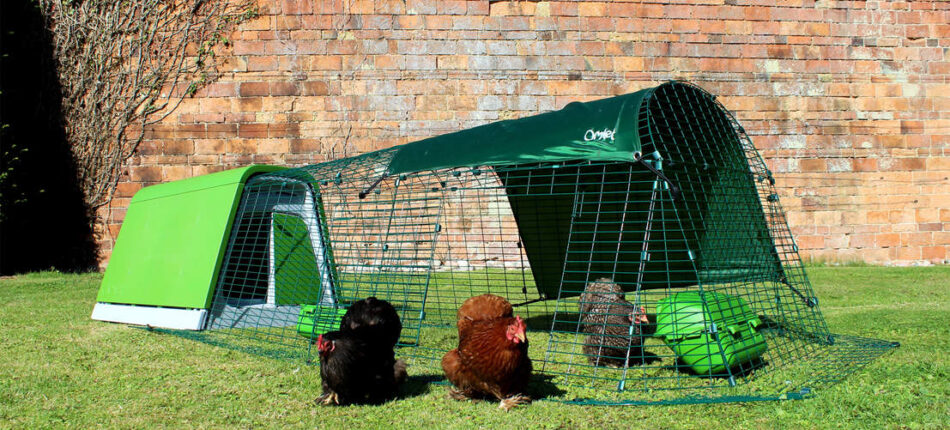
This entry was posted in Chickens

Worried about your chicken coop rotting? It’s a valid concern that all chicken keepers have. Chicken coops are out in the elements, and can take a beating from the weather and predators. Still, chicken keepers rely on their structural integrity to keep their flocks safe – so what happens when a coop starts to rot?
Thankfully, not all chicken coops rot. Wooden coops all eventually succumb to their exposure to the environment, but there’s an alternative option. We invite you to consider: Omlet’s plastic chicken coops.
Why do wooden chicken coops rot?
Wooden chicken coops, by nature, break down over time. No matter how “weather-treated” boards, planks, and roofs may be, they will eventually decompose when exposed to the relentless elements. This is especially true in areas that receive a lot of humidity and severe weather, such as the southern part of the US. A constant battering from rain storms, followed by intense sunshine will leach out the weather protectants that lumber may be treated with. Wind and rain will also loosen or warp shingles on chicken coops, making coops drafty and wet. Once the weather has stripped wood of its protectants, moisture sets in, and the wood begins its rotting process.
Wood that stays damp rots the fastest. Wet wood swells and expands, which allows for more moisture to make its way in. And, when exposed to the sun, swollen wood begins to contract when it dries. Through this process of swelling and contracting, wooden chicken coops begin to lose their shape as the boards or planks warp. You may notice bowed or split wooden components on your chicken coop as a result, which will eventually break or collapse. Different types of wood experience this process at varying speeds, but most commercially bought wooden chicken coops are made from lower-quality wood with a shorter lifespan.
Once the wood of a chicken coop begins to rot, any affected boards will need to be replaced. It’s important to address any rotten pieces of a chicken coop immediately to avoid adverse health effects on your chickens. Rotten wood attracts mites and other parasites that will plague your hens, and mold or mildew is often present in damp wood. These fungi can cause respiratory problems in your chickens, and creates unsanitary conditions for both you and your flock.
How to prevent your chicken coop from rotting
Oftentimes it’s easier to build or purchase a new chicken coop from scratch than to renovate a rotten one. Repairing a rotten chicken coop is costly and time-consuming, and will likely need to be repeated throughout the lifetime of a wooden coop. There are preventative measures you can take to maintain a wooden coop to help improve its longevity, but these too take effort and resources.
Repainting, staining, or weather-treating a wooden chicken coop
To help prevent wood rot, wooden chicken coops can be repainted, stained, or weather-treated regularly – usually on an annual basis. Take great care to select products that are non-toxic to chickens, and allow for ample drying time between coats before allowing your hens back into their house. Natural products such as tung oil can be applied to wooden chicken coops to make them water-resistant, but 100% pure tung oil can be costly.
Keep your coop covered
Another method to help prevent wood rot is to keep your chickens’ coop covered. This could be through the use of a tarp, inside of a structure such as a shed or a barn, or by building a structure over the top. It may seem a bit redundant to cover a chicken coop that is meant to protect your flock from the elements, but shielding a wooden coop from sun and moisture can help preserve its components. This isn’t the most convenient option, and application of water-resistant products will still be needed on occasion to protect the exterior of your coop.
Forgo a wooden coop
By far the easiest option to avoid having to fix a rotten chicken coop is to purchase a plastic chicken coop. Omlet’s Eglu Cube chicken coop is made of heavy-duty plastic that’s weather and waterproof, so there’s no concern over rotting components. Truly a zero-maintenance solution, the Eglu Cube is ready to house a flock of up to 10 small breed hens from the time it’s assembled. Omlet’s design is meant to last a lifetime, which means no breaking down or rotting, and no application of preservatives is required to keep your Eglu Cube sanitary and functional.
Why do plastic coops not rot?
The short answer as to why plastic outlasts wood is: because plastic does not exist in nature, naturally occurring organisms are not effective at breaking it down. Wood exists in nature, so there are bacteria and other living organisms that are equipped to dispose of it. Plastic, on the other hand, has no “natural” foes.
Plastic chicken coops do not rot or lose their shape in the elements and do not require routine maintenance. They’re also much easier to clean, offer a more sanitary environment, and are able to be moved with ease compared to their wooden counterparts.
How to maintain a plastic coop
All Omlet products are designed to last, but you’ll still want to check in on your chickens’ coop routinely for any signs of wear and tear. Usually, any doors or parts that are not aligning properly are the result of the soil beneath the coop shifting, and can easily be corrected by moving the coop by a few inches as needed. Chicken run clips may also come loose during these shifts, and should be checked regularly.
Aside from checking your coop for shifting, you’ll also want to clean your coop regularly to keep it fresh. Even deep cleaning the Eglu Cube takes mere minutes, as compared to several hours of cleaning a wooden chicken coop. A pressure washer or high-powered water hose makes the process go even faster. Simply remove the droppings tray and roosting rack, spray clean, and wipe dry.
Compared to wooden chicken coops, maintaining the Eglu Cube saves countless hours each year. And, a coop that’s so easy to clean and maintain creates a much more sanitary environment for your hens, which cuts down on illness and discomfort brought about by the weather. Keeping chickens has never been easier or more enjoyable than with an Omlet coop.
Omlet and your chickens’ perfect home
A rotting chicken coop is a frustration for chicken keepers that we sought to put an end to. The result is our line of high-quality chicken coops that stand the test of time. Combine your Eglu Cube with a Walk In Chicken Run for the ultimate chicken-keeping experience. And, with accessories such as the PoleTree Customizable Chicken Perch or Caddi Chicken Treat Holder, you’ll be able to foster and enjoy watching your hens fulfill their natural behaviors.

This entry was posted in Chickens

The Omlet Eglu Cube Chicken Coop helps make your chicken keeping lifestyle simple and fun! The double insulated walls ensure your chickens are always warm in the winter and cool in the summer, and the easy to clean surfaces make maintenance a breeze! But perhaps one of the best features that the Eglu Cube offers is its versatility!
Designed to fit flocks of all sizes, the Eglu Cube is the perfect coop for both the novice and seasoned chicken keepers alike. And if you are looking to create more space with your existing Cube, we’ve got everything you need to know!
Do my chickens need more space?
Whether you have 2 or 10 hens, you want your chickens to enjoy as much free range space as possible. Chickens aren’t that much different from us when it comes to space, and the more places we can explore, the happier we are! And the same is true for chickens! And we all know that happy hens = yummy eggs!
The Eglu Cube is the perfect hen house for all chicken keepers as it can house a wide variety of flocks:
- Up to 10 bantams OR
- 8 medium size hens OR
- 6 large breed hens
While the Cube itself is a perfect size space, allowing for even more room to roam is super beneficial to your feathered friends! Why? Because chickens like to have “personal space” just as much as any other animal! And at Omlet, who are we to stand in the way of a chicken and their space?
Versatility of Eglu Cube vs. traditional wooden coop
Our product designers carefully constructed the Cube with very unique features that allow for an easy housing system for both you and your hens! We know chickens and our mission with our designs is simple – provide a safe and easy to manage product that brings you and your animals closer and happier together.
So let’s take a look at just how versatile the Eglu Cube really is! We created the rear door panel to give you seamless access to the inside where you will find everything that you and your chickens will need. The separate nesting box creates a private space for the hens to feel comfortable and safe and also allows for chicken “alone time”.
Unlike traditional wooden coops that need to be painted and treated regularly, the Eglu Cube is completely maintenance free! A quick spray down with the hose to clean the messes and you will start to wonder why you haven’t been chicken keeping longer.
Walk In Runs and extensions
Are you looking to expand your flock? Or perhaps just add more space for your existing chickens to peck and play? Either way, we are here to help. Thanks to the modular and versatile design of the Eglu Cube, you can very simply create a henertaining playground for your chickens!
Walk In Chicken Run: The Omlet Walk In Run is truly customizable to fit any flock! Made from a strong and sturdy steel mesh, you can confidently place the Eglu Cube in the Walk In and let your chickens roam free without worry of any predator intrusion. The Walk In Run also provides a perfect way for you to actively engage with your feathered friends! Yes, even your 6ft tall friend can comfortably hug your hen as the run is designed for chickens – and humans! – of all sizes!
Chicken Run Extensions: Need even more space? No problem! The Omlet Chicken extensions were designed for exactly that purpose! With options of 3ft or 6ft widths and 3ft to 24ft lengths, you can literally customize your run to your specific needs. But what about when it rains? No need to worry! We have you, and your chickens, covered with the weather protection run covers! Rain or shine, your chickens will be just fine in the Walk In Run and Extensions!
Autodoor
The advancement of technology has made life easier for us, as well as our animals! And chickens are no exception. If you’re looking for the safest and most convenient way to let your chickens in and out of the coop, look no further than the Omlet Automatic Chicken Coop Door – the best hands-free chicken door on the market!
Chicken keepers everywhere love this door for its ease of operation and the added security it provides. Designed to fit both the Eglu Cube as well as a traditional wooden coop, the Autodoor can be operated by a light sensor or a timer. No longer do you have to jump out of bed in the morning or rush home at night to manually handle the coop door! Enjoy your life more freely knowing that your flock is perfectly safe with the Autodoor feature!
Wheels
A chicken coop on wheels? What more could any hen ask for?! By adding wheels to your Cube, you are able to find the perfect pecking spot in your backyard by moving your hen house anywhere!
And when the temperatures start to get colder, simply move the Cube closer to your house! Not only will your hens get the extra protection from your dwelling, but you also won’t have to walk too far in the cold to check on your chickens.
We know that you have many options when it comes to choosing a coop home for your chickens. That’s why we created the Eglu Cube to be everything a chicken keeper on any level could ever want or need. And with all of the extra accessories and options, your backyard beckons to be a spacious playground for your feathered friends!
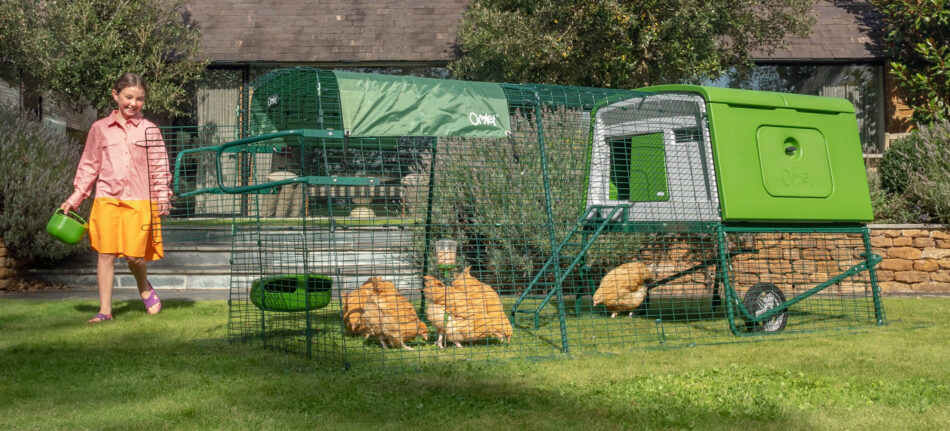
This entry was posted in Chickens
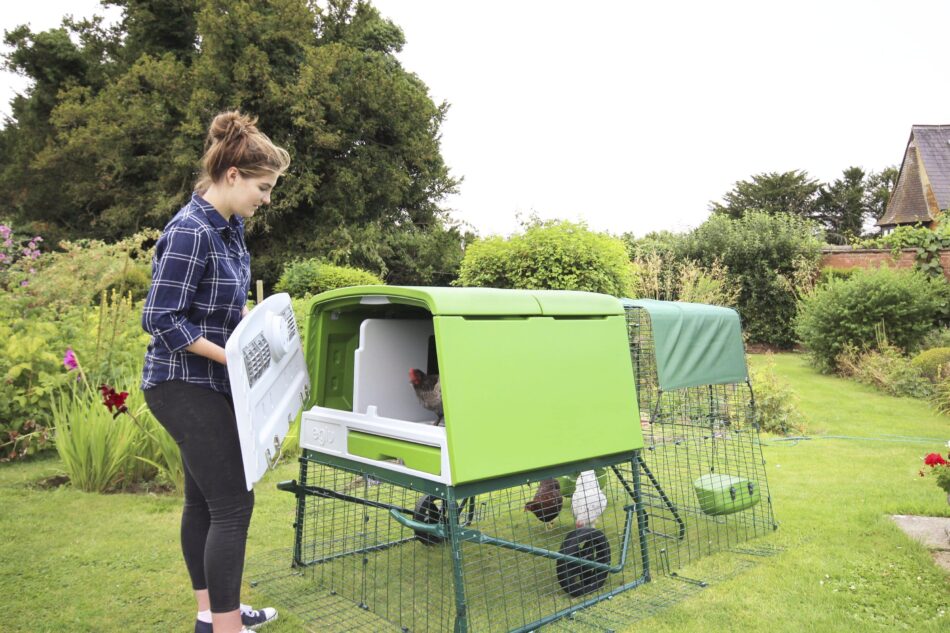
A quick search on the internet will provide a plethora of chicken coop options to purchase. But not all coops are created the same! At Omlet, our product designers know that keeping chickens is fun and simple, which is exactly why they created the easy to assemble and quick to clean Eglu Cube Chicken Coop.
Why you need an Eglu Cube
While wooden chicken coops have traditionally been used to house hens, there are better options available! Before you go buying a mini-house lookalike, take a read over all the reasons the plastic Eglu Cube is the best option:
- The material your coop is made of matters! The Omlet Eglu Cube is made of hard, durable plastic making it resistant to termites and parasites. Unlike a traditional wooden coop that needs to be treated, painted, and reroofed regularly, the Eglu Cube doesn’t require any of that maintenance – think of all the time and money you will save!
- The easiest to clean coop on the market! The product designers made this coop with clean-up in mind so all of the surfaces are easy to wipe down in minutes. No more need to worry about smelly chicken coops! In fact, all of the Eglu parts are easy to remove and even pressure wash clean if needed. Your hens will thank you for a sparkly clean and hygienically healthy home!
- It’s a weatherproof wonder! Chicken keepers from Florida to Fargo can attest to the outstanding weather performance of the Eglu Cube! Carefully designed with a unique double-wall insulation system, the Eglu allows your chickens to stay warm in the winter and cool in the summer. When tested against a traditional wooden coop in the cold winter of Germany, we concluded that a winter ready chicken coop like the Cube can make all the difference between a cozy night’s sleep and one spent shivering to keep warm!
Hassle-free Cube = hassle-free chicken keeping
Some people may object to keeping chickens for reasons that include smell, time commitment, and space. But the reality is that these are all just chicken myths, and with the right products and preparations, chickens are low-maintenance pets. The Eglu Cube from Omlet helps to make that job easier!
SMELL
So you think chickens in your backyard might create a bad smell? Well, the truth is, chickens are actually clean animals. The smell that many are afraid of isn’t from the chickens themselves, but rather from the chicken droppings. But, with the easy to clean Eglu Cube, you can spray down your coop in minutes and avoid any unpleasant odors.
TIME
Like any animal, owning chickens requires a time commitment! Just like cats and dogs, they need daily food and water and physical and mental stimulation. Other than that, they are self-sufficient animals! Investing in the Eglu Cube allows you to save even more on time with its easy assembly! We had the novice chicken-keeper in mind when designing this coop, so we created a product that is super easy to put together. In fact you just need one tool to get started!
SPACE
Probably one of the biggest myths in owning chickens is that you need to have a huge backyard to house your hens! For the average chicken-keeper, a regular sized backyard will do just fine! The great thing about the Eglu Cube is that you can opt to add wheels to the coop allowing for it to be movable by one person to another location. What chicken wouldn’t like a house on wheels?
Step-by-step guide
Choosing the right chicken coop can be the hardest part of chicken keeping. So now that you have decided on the Omlet Eglu Cube, let’s take a look at the 7 simple steps to assemble your hen’s new house!
- STEP 1: Grab a screwdriver and a friend. Yes, that’s all you need to put together this super easy to assemble coop! All of the materials are included in the boxes upon arrival, so you simply need to lay everything out to get started. If you want, you can even watch this tutorial video to follow along each step!
- STEP 2: Now it’s time to construct the frame! With the help of a friend, follow the detailed step-by-step instruction manual to build your coop base. Made from heavy duty steel, this frame is not only strong but will keep your chickens safe and secure.
- STEP 3: Now it’s time to get rolling! If you opted for the wheel accessories, this step includes their installation. The moving mechanism of the Eglu Cube wheels was created to allow for one person to move the coop with ease!
- STEP 4: Time to install the run – a chicken’s favorite part! The size of the run you buy depends on how many chickens you plan on keeping. The goal should always be to give your chickens the most space you can – either free range in the backyard or with a bigger walk-in chicken run. And if you find it hard to decide which is best for you, just contact our customer service and we will be happy to help!
- STEP 5: You’re almost there! Now it’s time to assemble the cube house and attach it to the frame! Made from 100% recyclable and UV stabilized polyethylene (super strong plastic!), you will have peace of mind knowing your chickens are in the best built hen house on the market.
- STEP 6: It’s accessory time! One of the greatest benefits of the Omlet Eglu Cube is all the optional accessories you can add to your hen house! The essential feeder and waterer bins are constructed from the same strong material as the house and designed to be just as easy to clean! You can also add the automatic chicken coop door which allows your chickens (and you!) to sleep soundly at night knowing that predators cannot get in!
- STEP 7: All that’s left to do now is add your flock! You have just built an efficient and practical home for your chickens that can stay with them for years to come.
Maintenance of your coop
While Omlet products are known for their durability, we always recommend regular maintenance on all products to ensure you will get the most out of them! The Eglu Cube is practically maintenance-free with its super easy to clean design, but there are few things you can keep your eye on when out and about with your chickens to make sure stability and security are 100%.
- If you notice any run clips not as tightly secured, it may be time to replace them.
- If you are a seasoned chicken-keeper and purchased an Eglu Cube before summer 2019, you may start to notice some wear on the previously provided friction stair strips. Consider upgrading your coop with the Eglu Cube ladder grips that not only make it easier for your chickens to walk in and out of the house, but are more durable as well!
- While the cube house is completely covered and protects your chickens from the elements, many chicken-keepers add run covers for added protection when the chickens are roaming the run.
One of the greatest gifts of chicken keeping is, of course, the benefit of wholesome, fresh eggs! But chickens can also be very henertaining! After long, you will notice you are loving your chickens just as much as your four-legged pets. So when it comes to making sure they have the best life possible, be sure you get them the best house!
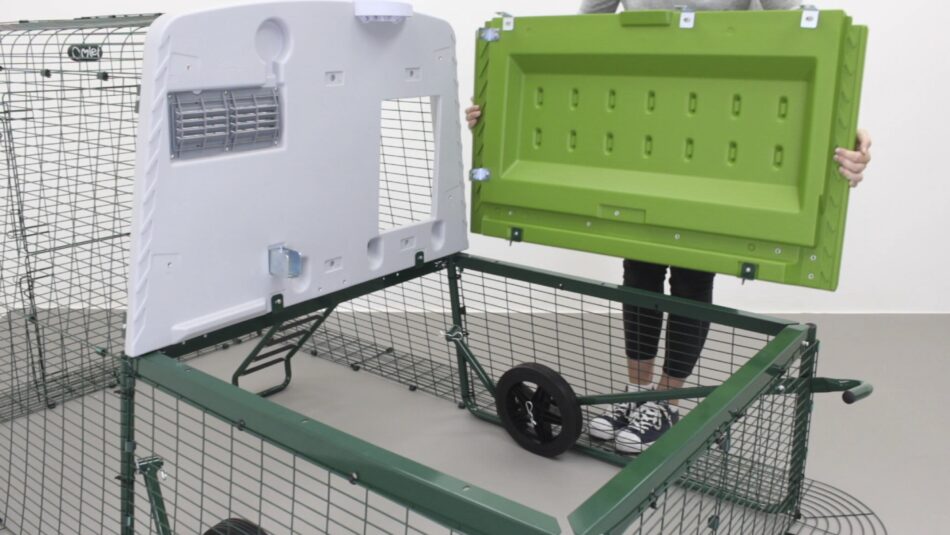
This entry was posted in Chickens
The Eglu Cube chicken coop is built to last – whatever gets thrown at it. The durable, twin-wall chicken house and heavy duty, steel weld mesh is strong enough to protect your chickens from hurricanes, tornadoes, bears, bobcats and more. These case studies are just some of the many stories from happy chicken keepers around the world.
This Eglu Cube survived a hurricane!

All parts for the Eglu Cubes are available as spares so if anything gets damaged you can easily repair it. Contact our friendly customer service team by email or phone, and they’ll be happy to help.
The Eglu Cube chicken coop holds firm against strong winds and hurricanes, and is easy to tie down or move into a sheltered area. After Hurricane Ian hit Florida at 150 miles per hour, Jeremy was astonished to see his Eglu Cube still standing, unmarked in the thick of the aftermath.
“Our Eglu (unbelievably) survived Hurricane Ian. We are 3/4 of a mile from the Gulf of Mexico near where the hurricane made landfall. Venice is badly damaged. Our neighbourhood, in particular, took a very big hit.
Our entire back yard was destroyed. The fence is a complete loss. Several large (30+ foot) pine trees fell down, including one into the neighbour’s roof and one that snapped the power pole in half. But the Eglu did not have a single scratch. We moved the chickens back in right away.”
Jeremy – Florida, USA.
This Eglu Cube survived a bear attack!
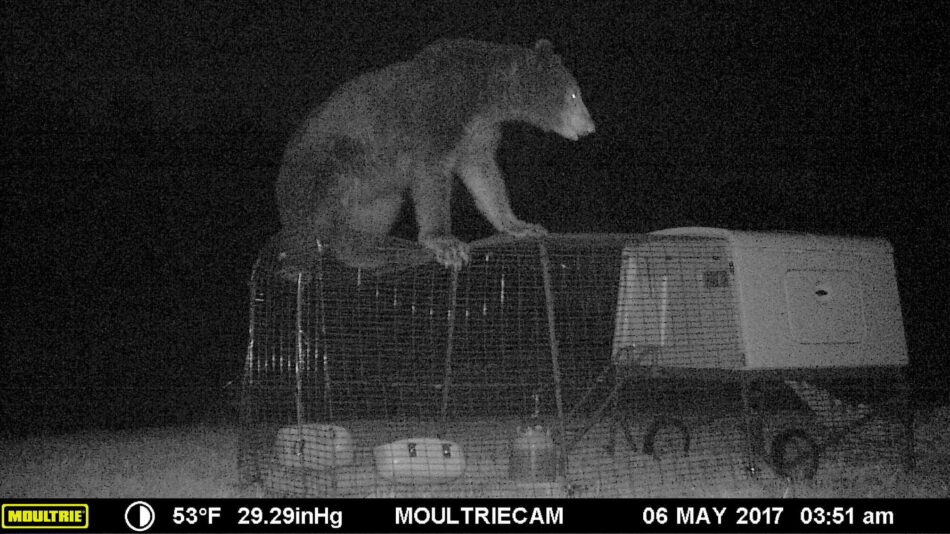
When you live in a rural area, with black bears for neighbours, it’s understandable to be worried about your chickens. But Tom’s Eglu Cube quite-rightly earned his trust when a 300 pound bear was unsuccessful in its attempt to break and enter his chicken coop in Virginia.
“We live in an area with black bears, coyotes, foxes, and other predators. Over the weekend our Eglu was attacked by a 300 pound black bear and despite the wire roof being smushed with its weight, the Eglu remained intact and no chickens were harmed. We most likely will need an electric fence but we were impressed with the coop being able to withstand the assault. Very impressed! Also, with 2 young children the Eglu is easy to clean and maintain – minimal maintenance required and our boys able to open and close the doors. Outstanding! The best coop we could have with our rural area and lifestyle”
Tom – Virginia, USA.

Over in California, Tracy and her sweet silkies also had an unwelcome visitor in the form of a large bobcat. But thanks to the Eglu Cube, Tracy enjoys peace of mind knowing her girls are safe and sound.
“We are the Lloyds, and we live in San Diego, CA. We have four silkies – Elsa, Nugget, Ickey, and Shuffle. They are the cutest and sweetest, little bunch. They like to stick together, and scratch for bugs, worms, and other treats.
The predator in the video is a bobcat, but we also have coyotes, owls, hawks, and more. Our house backs to a canyon, and we have frequent visits from various predators. We have so many visits, that I do not allow my poodles to go outside in the backyard unless they are next to us, and we are actively watching them, but I’m confident the hens are safe in their coop.
We purchased an Eglu Cube because we love our silkies, and we wanted to keep them safe. Although we still have a motion-sensor camera to monitor, the silkies have been happy and safe!”
Tracy – California, USA.
This Eglu Cube survived a fallen tree!
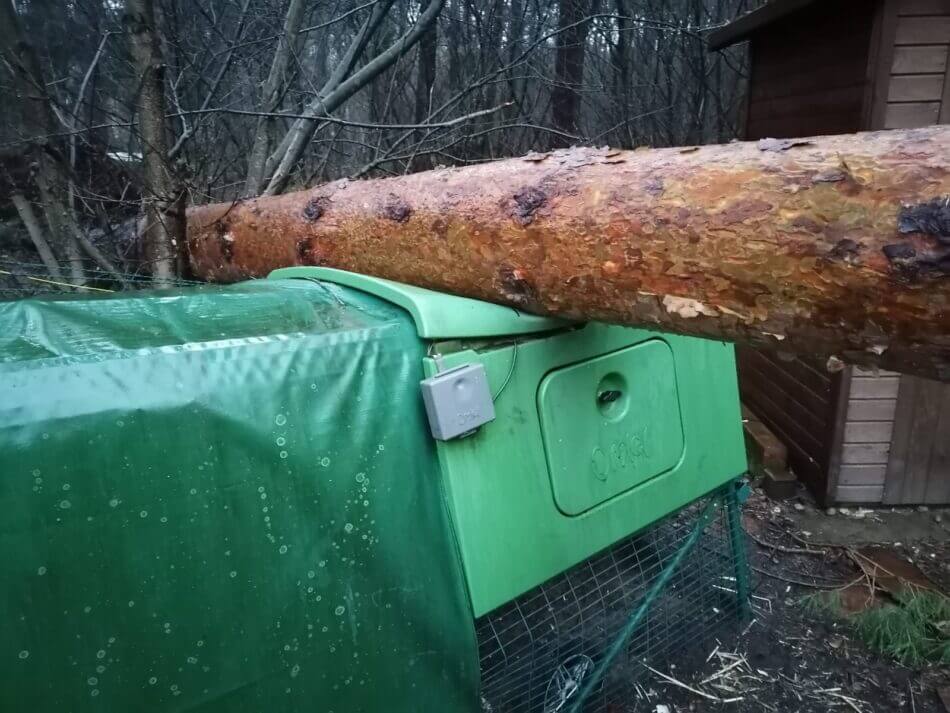
Thanks to the thick, twin wall house and steel frame, the Eglu Cube chicken coop is unaffected by the roughest of storms and its path of destruction. Anna from Germany saw for herself when a fallen pine tree squared up to the Eglu Cube.
Man, did we have a few stormy days! Everywhere in the neighborhood, trees were falling left, right and centre, and one of them on the edge of our premises, exactly where our Eglu Cube chicken coop is!
The giant pine tree fell across our Cube, but when we came out to check on the hens we couldn’t believe our eyes. The tree was resting right on top of the Eglu, but it hadn’t been damaged at all. As soon as the Autodoor opened, the chickens walked out and started to scratch around as if nothing had happened, and we could collect fresh eggs that same afternoon.
After some serious chainsaw work we were able to investigate the Cube, finding that only one roof panel was damaged, but we could even bend that back a bit. Unbelievable!”
Anna – Germany
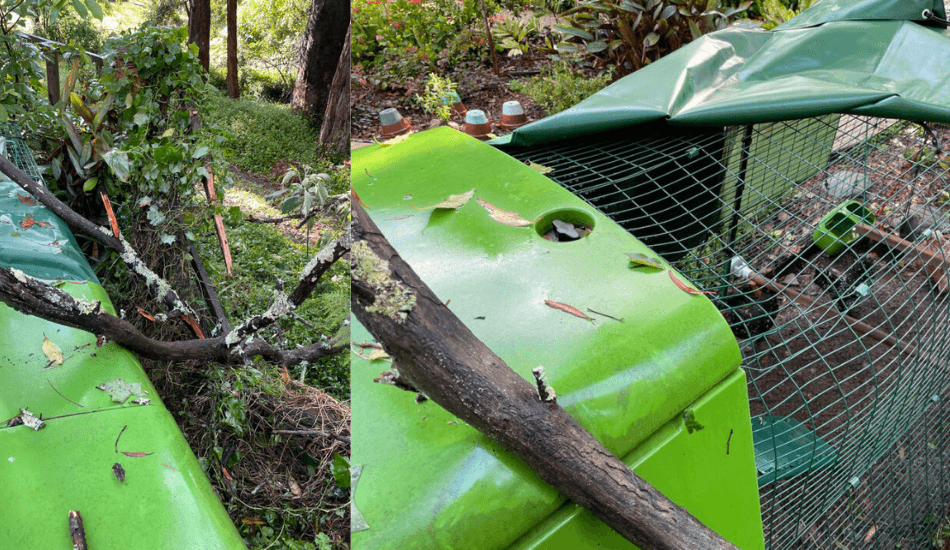
Months after replacing her rotten wooden coop, Ashleigh was relieved to find her hens unharmed after severe storms had blown down a large tree, crushing her fence, but stopped in its tracks by the reliable Eglu Cube chicken coop.
“We’ve had storms overnight and went to let the chickens out this morning to find a large tree had come down from the bush behind the house and had landed on our fence and chicken coop. The fence couldn’t withstand the impact, but the Eglu Cube did. We replaced our old wooden coop with the Omlet one a few months ago as the wooden coop was rotting in our humid mountain air, and we’re so glad we did. Not only is it so easy to clean, I don’t think our chickens would have survived the tree falling on the coop. The coop does need some repairs as the run and coop itself have buckled, but I still can’t believe how strong it is.”
Ashleigh – New South Wales, Australia.
Tornado – yep, this Eglu Cube survived one!
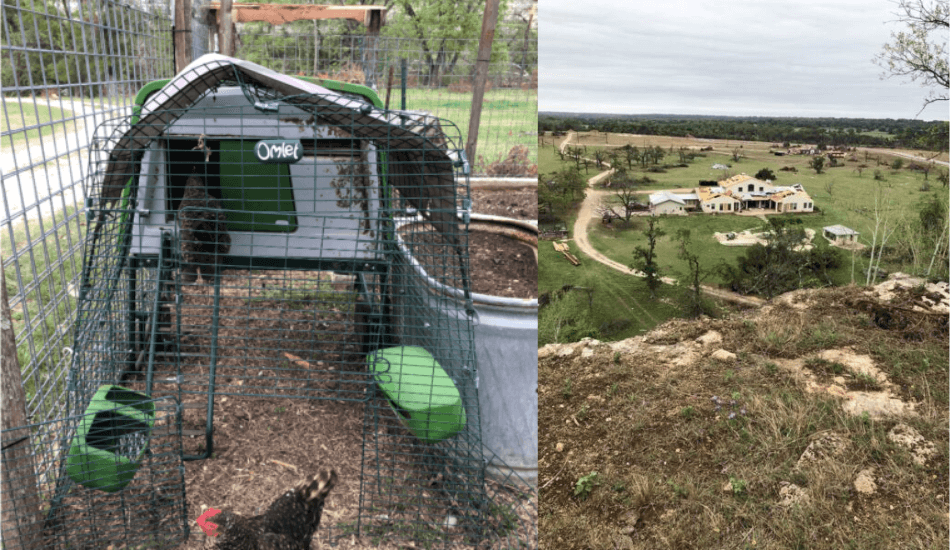
Despite needing a good clean and a reshape, Lori’s Eglu Cubes survived a direct hit from a severe tornado in Texas, and her hens were unharmed – though a little shaken by the whole thing.
“We sustained a direct hit from a F3 (almost F4) tornado in April. Much of our ranch was destroyed (hay barn completely gone, barndominium, horse stalls and woodshop required demo to slab, house currently unliveable). We lost two cows and many trees. But, we survived in our tornado room with our dogs and our 2 Omlet Cubes and all of our chickens survived. One Cube was completely upside down and the other was trapped by fallen tree limbs and debris. The chickens were trapped by our hawk netting that collapsed with the tree limbs; actually fortutios and I think they would have been blown away – ah, the story they could tell! We were able to turn the one coop upright and get them all in one for that first night. Yes, 12 wet hens can fit in an Eglu Cube!
While the run and skirting are bent up, and I had to remove a few pieces of skirting, they are still functional. The back door on one sustained a hit that broke a small piece of plastic that makes the handle a little loose, but still functional. The Autodoors still work, one of the shade covers survived, as did the food and water bowls! Other than being scratched up, very dirty and with misshapen runs, they are fine! They have since had a thorough washing and if you didn’t look at the bent run, you’d never know anything happened! Thanks for making such a great product!”
Lori – Texas, USA.
Eglu Cube – 1, Mountain lion – 0

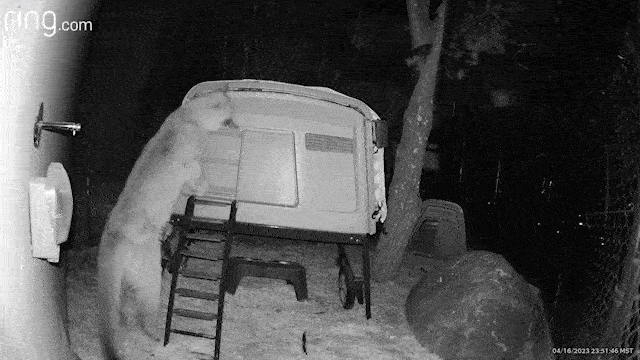
Pesky predators are no match for the Eglu Cube. Watch how this crafty mountain lion in Arizona made several attempts of sneaking their way into the Eglu Cube. But with its unique indestructible and anti-predator design, even the biggest of cats are left baffled by this coop.
Dug Rothrock – Arizona, USA.
This Eglu Cube saved hens from the flames
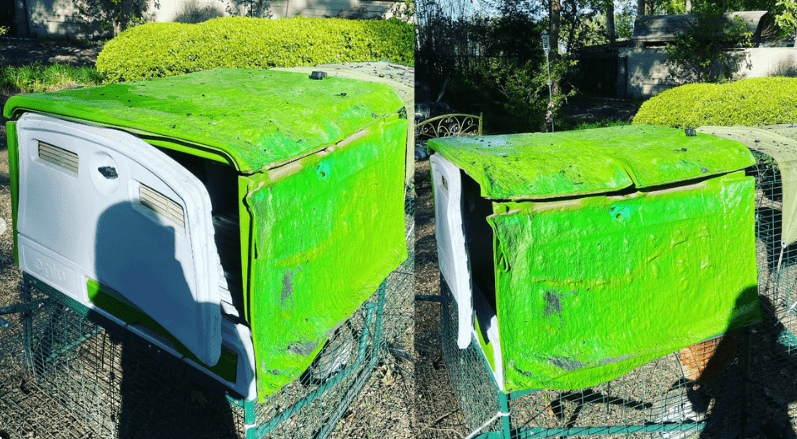

Disaster struck Erin from Arkansas when their backyard went up in flames. Fortunately, their hens were tucked safely away from the fire in their Eglu Cube chicken coop, which was able to withstand the terrifying event. Whilst the coop has been left with visual reminders of the blaze, Erins’s chickens survived thanks to the hard-wearing materials of the Eglu Cube.
Erin – Arkansas, USA.
So, how strong is the Eglu Cube chicken coop? From wild weather to wild predators, you and your chickens can rest easy with the Eglu Cube chicken coop, designed by Omlet and trusted by thousands of chicken keepers.
Got an amazing story to tell? If your Eglu has saved your hens from stormy weather or unwelcome visitors, please email us at blog@omlet.us.
This entry was posted in Chickens
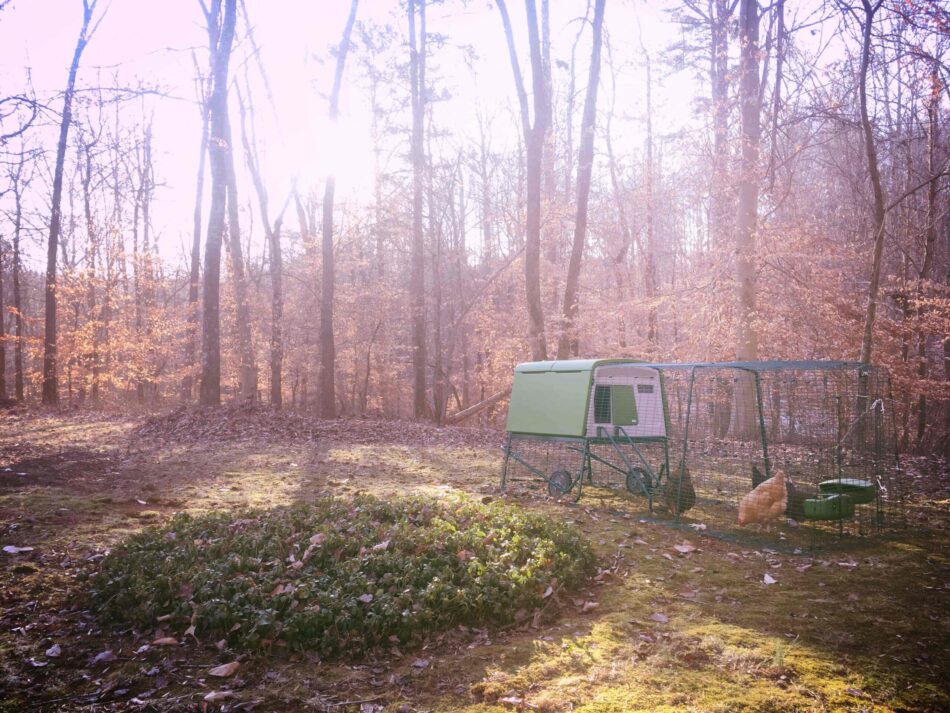
It’s that time of year again when we say goodbye to summer and welcome in the cooler, shorter fall days. For many pet owners, summer is a great opportunity to spend quality time with their animals; playing outdoors and enjoying the warmer weather. But, the change in season doesn’t have to mean that the good times have to stop. So whether you’ve got a chicken, guinea pig or are a pet parent to rabbits, here are 8 tips for making their run more fun this fall.
Why do pets need runs?
It’s important that you continue to keep your pets exercised throughout the year, and animal runs are great for this, giving your furry friends the freedom to roam within a safe and confined environment. Omlet has a range of runs for chickens, rabbit runs and guinea pig runs, which are all predator-resistant, with their innovative mesh designs.
Whilst runs are fantastic for providing your animals with more space, adding a few extras over the next coming months can help to keep both you and your pets entertained.
For guinea pig and rabbit runs
Pig out on veggies
Cavies and rabbits love their fresh veg – you can even make a game of it! Try hiding their favorite pieces of veggies around the run and have them go off to find their treats. This game is the perfect opportunity for you to spend some quality time outside with your pet. Just don’t forget to clean up any remains from the run floor to avoid pesky predators sniffing out the snacks.
Or, use the Omlet Caddi rabbit treat holder or guinea pig treat holder to keep your pets’ brains engaged. Simply fill the treat holders with your rabbit or guinea pig-safe vegetables and watch them spend time navigating how to get them out. Take a look at some suggestions for rabbit treats and guinea pig treats here.
DIY adventure playground
Upgrade your pets’ run to an adventure playground with pet play tunnels. They can simply be attached to your guinea pig or rabbits’ run and provide them with a new way to exercise. Plus, they’ve been designed to mimic the innate burrowing behaviors of rabbits and guinea pigs too.
Shelters can also be a great addition to your run this season. The Omlet Zippi Shelters for rabbits and Zippi Shelters for guinea pigs are weatherproof too, meaning that your pet will be protected from the elements in fall.
And since both pets have a natural desire to seek a hiding space in a hole, you can be assured that while they’re having fun, they’re feeling safe. The Zippi shelters easily attach to the Omlet play tunnels via connector rings, too, which means you can create a fun maze for your furry friends.
Guinea pig and rabbit toys
Who said toys were just for cats and dogs? Give a new toy to your small animal to help to bust their boredom this season. Toys for guinea pigs and rabbits can simply be hung up in their run and will keep them active, engaged, and curious.
For chicken runs
Make use of those crisp, fall leaves
The leaves of fall in your backyard can actually be a great source of entertainment for your chickens. All you have to do is build up a pile of crisp fall leaves in your chickens’ run, and watch them have endless hours of fun pecking. You can even add some sunflower seeds to your pile to have your flock hunt for.
Omlet’s Chicken Swing
Omlet’s Chicken Swing is the perfect way to make your chickens’ run more fun this fall. The Omlet Chicken Swing will have your chicken in their element, as they get to grips with their new toy. Not only will this run accessory provide them with plenty of entertainment, but you’ll have just as much fun watching them hop on and off and swing back and forth.
Toys for chooks
Chickens can have toys too. A bored chicken can lead to behavior such as flock bullying and abnormal feather loss, so at this time of year it’s even more important to keep your chickens entertained. Naturally, as the weather drops, these animals get increasingly restless, with less grass and weeds for them to forage on, as they enjoyed over the summer. A chicken peck toy though, is one option to keep your flock happy, providing them with physical and mental stimulation.
Pumpkin run fun
It wouldn’t be fall without pumpkins! Simply place half a pumpkin in your chickens’ run for them to have as a special treat. Your flock will have no problems pecking at the pumpkin raw, so there’s no need for any cooking; just slice the top of the pumpkin off and then in half, to place outside in their run. Something to be cautious of here though, is to ensure that you remove any pumpkin remains from the run once finished to avoid any unwanted visitors such as rodents at night.
Omlet and your pets’ fall
Omlet knows that this time of year can be more difficult for pet owners but whatever the season brings this year, with Omlet’s range of guinea pig, rabbit and chicken products you and your pets can continue to have fun all fall long. And, as the end of the season brings colder weather, don’t forget to have a read of the Omlet guides on keeping your guinea pigs, rabbits, and chickens safe and warm when they’re outdoors.
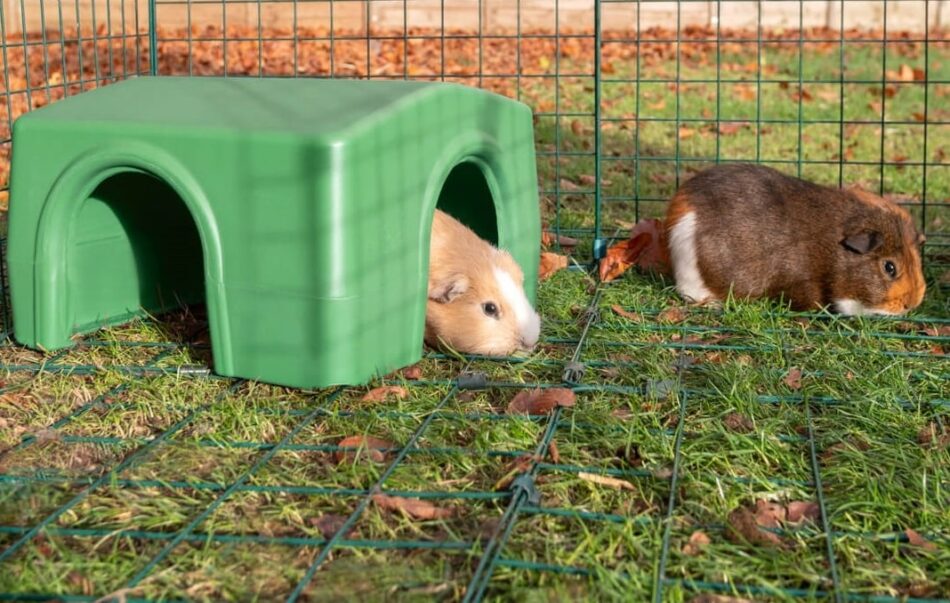
This entry was posted in Chickens
It’s often hard to tell if a hen is laying. Hens do not produce the same number of eggs each week throughout the year, and there may be health- and environment-related changes to egg production, too.
It’s useful to know when a hen stops laying, as you can then give her a quick health check to identify the cause of the interruption. But how do you tell which chicken is not laying eggs? In a coop of six hens, in which the daily average number of eggs is five, it’s not immediately obvious which hens are laying.
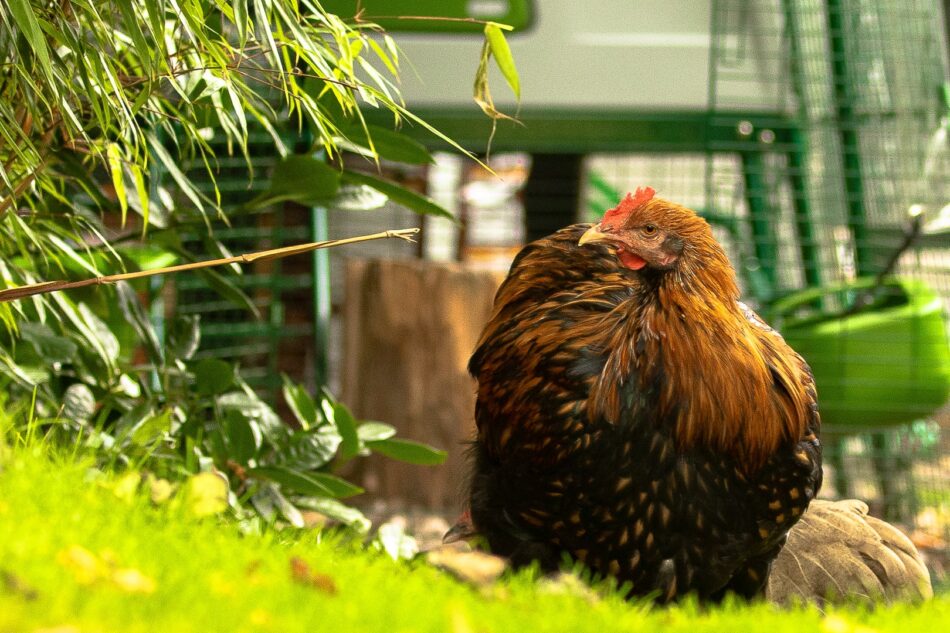
Seven signs that a hen has stopped laying
1. Age. This is the most obvious cause of a drop in egg production. Over her egg-laying years, a hen’s production will tail off. This is natural, and it does not mean the chicken has reached the end of its usefulness. All hens play a part in the social order of a coup, and a bird reaching the end of its egg-laying life will still be as feisty, active and lovable as the younger birds – and she’ll still lay the occasional egg.
2. Molting. This occurs every year once a hen is 18 months old (although younger birds may shed feathers, too). The signs are very clear – lots of feathers lying in the coop, and bare patches appearing on the hen. During this time, chickens need to produce lots of new feathers, which is a physically demanding process. Consequently, egg-laying is reduced, and sometimes there will be several days without an egg. The molt tends to occur in the autumn, but it depends on when the hen first started laying. Molting takes 8 to 12 weeks, occasionally longer.
3. Vent. A dry vent – the hole through which the hen lays her eggs – is a sign of no production. In a hen that is still laying, the vent will be moist.
4. Abdomen. Your chicken’s abdomen area should feel soft and rounded. If the area below the breast bone is hard and swollen, this can be a sign of egg peritonitis, a bacterial infection in the chest cavity. Your chicken will still produce a yolk but is free-floating in the abdominal cavity. Affected hens will stop therefore either completely stop laying eggs or only lay soft-shelled, thin, or misshapen eggs.
5. Comb and wattles. A healthy laying hen tends to have bright red comb and wattles. These become duller when she is about to lay, but turn bright red again once she has laid the egg. If the comb and wattles are pale or dull looking all the time, it could be a sign of illness.
6. The food dye test. If you put a small dab of food coloring on a hen’s vent, the color will be transferred to the egg. The color that fails to appear tells you who the non-layer is. This is only practical in smaller flocks, though, given the limited palette of food colorings…
7. No eggs. This isn’t as silly as it sounds! If you only have a few hens, and they are different breeds, you will often come to recognize which eggs are produced by which hen. In this case, the sudden disappearance of one particular egg-type will tell you who’s not laying.
Five reasons why hens stop laying eggs
1. Temperature and sunlight. Seasonal factors play a part in egg production. As the daylight hours lessen in autumn and winter, hens tend to lay fewer eggs. In the depths of winter, the low temperature becomes the cause, as a hen needs all her energy to produce body heat. With her resources diverted to this essential function, egg-laying is put on hold.
2. Stress. Any form of stress will tend to interrupt or stop egg production. Stress can be brought on by several things, including parasites, bullying, injuries and fear (of noisy dogs, for example).
3. Diet. Poor diet can impact egg production, too. If a hen is laying, she needs all the essential nutrients – not just calcium – to produce eggs. Top-quality layer’s pellets will contain everything the hen needs. A hen that fills up on treats before filling up on pellets may become malnourished and stop laying. It’s a good idea to let the chickens feed on their pellets first thing in the morning and last thing at night, and only offer corn and treats in the middle of the day.
4. Broodiness. A broody hen – that is, a hen who has decided to sit on her eggs in an attempt to hatch them – will stop laying. There are several ways of discouraging broodiness, but some hen breeds are more prone to it than others. If all attempts to dissuade her from leaving the nesting box, you have the consolation that after 21 days – the time it would take for a fertilized chicken egg to hatch – the hen’s self-inflicted ordeal will be over and she will resume normal life – including egg-laying.
5. Change of routine. If you move the hen house or introduce new birds to the flock, or if one of the hens dies, the birds’ routine and pecking order will be interrupted. This often causes them to stop laying for a short time, until their social lives settle down again.
Four ways to encouraging laying
1. Comfy coop. The first thing to do is to make sure the hens’ environment is adequately equipped and comfortable. Check for red mites, as an infestation of these nocturnal parasites can stop egg production. Reduce drafts and make sure there is no bullying going on – often a sign of an overcrowded hen house.
2. Light. Some chicken keepers install lights in the coop to encourage laying in the colder months of the year. However, bear in mind that a chicken can only lay a finite number of eggs in its lifetime. If she’s naturally programmed to lay 1,000 eggs, encouraging her to lay regularly throughout the winter will simply reduce her laying life.
3. Eggs. If an apparently healthy hen isn’t laying, she can be encouraged by leaving eggs in the nesting box, or placing rubber ones, or even golf balls, in the spot where she is supposed to lay. The sight and feel of these will encourage her laying instincts.
4. Reduce stress. Discourage dogs from disturbing the hens, and make your run and coop are as predator-proof as possible. Equally important, make sure the run isn’t overcrowded, and provide enough roosting space in the coop for all the hens to rest comfortably.
Disappearing eggs
If your hens are free-ranging, they will sometimes lay an egg in a quiet corner of the backyard. This can become habit-forming, and if she’s doing it in secret, you may reach the incorrect conclusion that the hen isn’t laying.
A healthy hen who does not appear to be laying may be the victim of egg sabotage. A predator, a human thief or an egg-eating chicken might be removing the evidence of her labors. The best way of preventing this is to encourage your hen back to the nest box for laying. In crowded coops, a hen will sometimes seek an alternative laying place if the boxes are all full when she feels the urge to lay.
As a hen ages, she will produce fewer eggs. If you are uncertain of the age of your chickens, there is a simple test you can conduct that might sometimes give you a clue. Place your hand gently on a hen’s back. If she immediately squats down, it means she is still fertile and therefore producing eggs. Hens squat when they are mating, and it is an automatic response.
Although egg production drops as a hen ages, it will often continue throughout her life. The occasional egg from an old hen always reminds you what a wonderful friend she’s been throughout your long time together!
This entry was posted in Chickens


Your chickens’ coop should be a space for your flock to eat, drink, lay eggs, and sleep. It should also be a place for your chickens to feel safe and be protected from the outside elements or any danger. However, sometimes chickens may suddenly decide that they do not want to go into their coop at night, which can be for a number of reasons. Here are some explanations as to why this could be happening.
A Broody Hen
Hens can get broody, regardless of if you have a rooster. Although many hens will decide to stay in the nest of their coop so that they can sit on their eggs, others like to search for a quiet space away from the coop, which can mean remaining outside the coop all night.
Moving a broody hen can be highly stressful for them, so should you decide that it’s best to move your hen inside the coop, due to safety concerns, you need to take great care when doing so. One way to start is by collecting your hen’s eggs regularly (twice a day). Be sure to wear leather gloves when doing so, as a broody hen is likely to be aggressive around you as they are very protective of their eggs. You’ll also want to reduce the light supply when you move her, as the moving process situation will be less traumatic in the dark.
Predators
Predators such as foxes, cats, rats, and badgers could be one reason as to why your chickens have stopped going inside the coop at night. These animals will spook your flock, with smaller predators such as badgers having the potential to gain access inside the coop by climbing over the fencing, or squeezing through small openings in the coop’s wiring.
Luckily, there are a few steps you can take to deter these animals and have your chickens back in their coop every night. One option is to get a motion sensitive light installed, which will scare off any unwanted guests. Alternatively, take a look at the Omlet chicken coop range. All of the Omlet coops are predator resistant, which will reassure you that your chickens will be safe from any night time visitors. With anti-tunnel skirts that lie flat on the ground, and heavy duty steel weld mesh, these features will help to prevent animals from digging in. You can also purchase the Omlet automatic coop door which shuts your chickens away in their coop at night to keep your flock secure, enclosing them until the time you set for the door to open in the morning.
An Overcrowded Coop
Chickens need their own personal space, hence why many chickens are also kept free range. Not only is overcrowding an unpleasant experience for chickens, causing them to avoid the coop at night, it can also lead to further complications such as the build up of ammonia and an increase in disease. The solution? The more space the better! For size reference, the Omlet Large Eglu Cube chicken coop can comfortably accommodate six large hens or up to ten bantams.
Tensions Amongst Your Chickens
 Unfortunately, bullying amongst chickens happens, and isn’t actually too uncommon of a problem. Chickens naturally create a pecking order, whereby the flock will establish themselves in a social hierarchy of strongest to weakest chicken. However, if aggressive behavior continues after the head rooster, or the dominant hen in their absence, has found their way to the top of the ladder, you may be dealing with a bully. Common signs are missing feathers from a chicken’s back, unusual weight loss, reduced egg production, or blood from where the victim has been pecked, all of which could lead to a chicken/s refusing to go into their coop at night.
Unfortunately, bullying amongst chickens happens, and isn’t actually too uncommon of a problem. Chickens naturally create a pecking order, whereby the flock will establish themselves in a social hierarchy of strongest to weakest chicken. However, if aggressive behavior continues after the head rooster, or the dominant hen in their absence, has found their way to the top of the ladder, you may be dealing with a bully. Common signs are missing feathers from a chicken’s back, unusual weight loss, reduced egg production, or blood from where the victim has been pecked, all of which could lead to a chicken/s refusing to go into their coop at night.
To stop the bullying, and therefore get your chickens back in their coop at night, first try to establish the cause. Common reasons for bullying can be an injured or ill bird, having a large flock, or your chickens being bored. However, should the bullying continue after attempting to resolve what you believe to be the cause of conflict, you can purchase anti-pecking spray, which will discourage feather pecking. Alternatively, separate the bully from the flock. Isolating the bully for a week may mean that they lose their dominant position in the hierarchy once they are reintroduced.
Mites and Parasites in the Coop
Pests are a very common cause for chickens to have stopped going to their coop at night. Red mite in particular is a likely culprit, a parasitic mite that lives inside chicken housing and lays eggs in cracks near nests. They can make your chickens restless at night, as they live inside chicken coops and crawl onto the chickens to feed on their blood as they sleep. Only active during warmer weather, red mites are also more likely to strike wooden coops.
Red mites are not the easiest thing to get rid of, however, one solution is to purchase red mite treatment, which works by immobilizing pests with its sticky consistency. Rest assured, it’s also completely safe to use in the chicken feeding area, so you do not have to have any concerns about your flock digesting the product.
Luckily, chickens are creatures of habit, so once you’ve identified the cause, you should be able to get your flock back into the coop at night in no time!
This entry was posted in Chickens
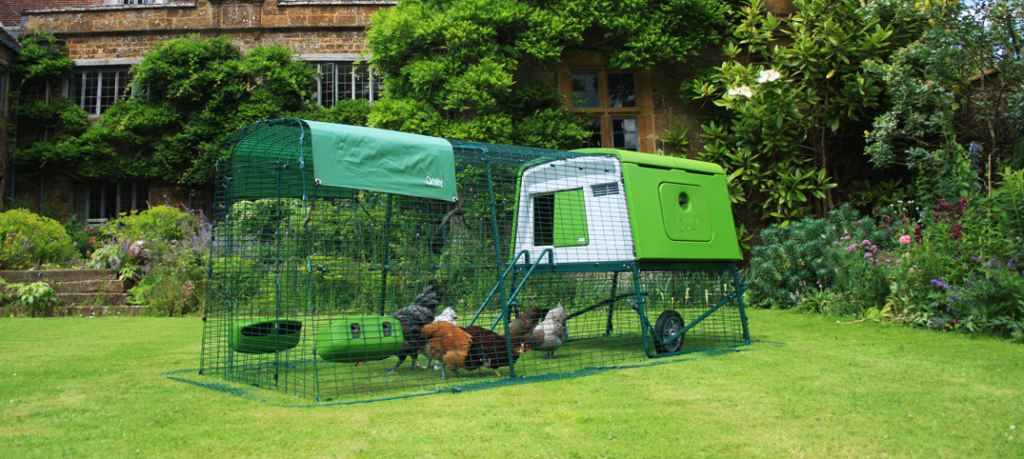
The metal chicken runs are designed to be used outdoors for years to come. However, we recommend that you check the run regularly for signs of corrosion, especially if you live somewhere with extreme weather conditions or close to the sea. Corrosion will occur if the coating has been scratched or scraped for example. If you do see some, remove any loose rust and touch up with a weather resistant paint.
Are you a long term Eglu or Walk in Run owner? Omlet products are known to be extremely long lasting, but we do recommend checking over your coop and run every year for signs of wear and tear, and to remember the little maintenance needed to keep your coop in tip top condition and your pet happy and healthy. You may have also missed some of the new products we have developed over the years to make the coop and runs even better. Take a look at ways you can upgrade and improve your Eglu below!
Run Clips
When you carry out your regular deep clean, make sure you have a quick walk around the run and check the security and stability of the run panels. In time, the run clips can age and become weaker. If you notice that run clips are cracking when you open them or move the coop and run, or that there are some clips falling to the ground, you should consider refreshing all the run clips on your coop.
We have now made it super quick and easy for you to find the right pack of run clips for your Eglu or Walk in Run.
New Ladder
If you purchased your Eglu before summer 2019, you may not have benefited from the new Ladder Grips we have designed to resolve the problem of some chickens disliking the metal coop ladder, or being too small for the steps. The ladder grips replace the black friction strips, clipping on securely and easily to provide a wider platform for chicks to climb up on.
You can buy ladder grips for your Eglu Cube here or for your Eglu Go UP here.
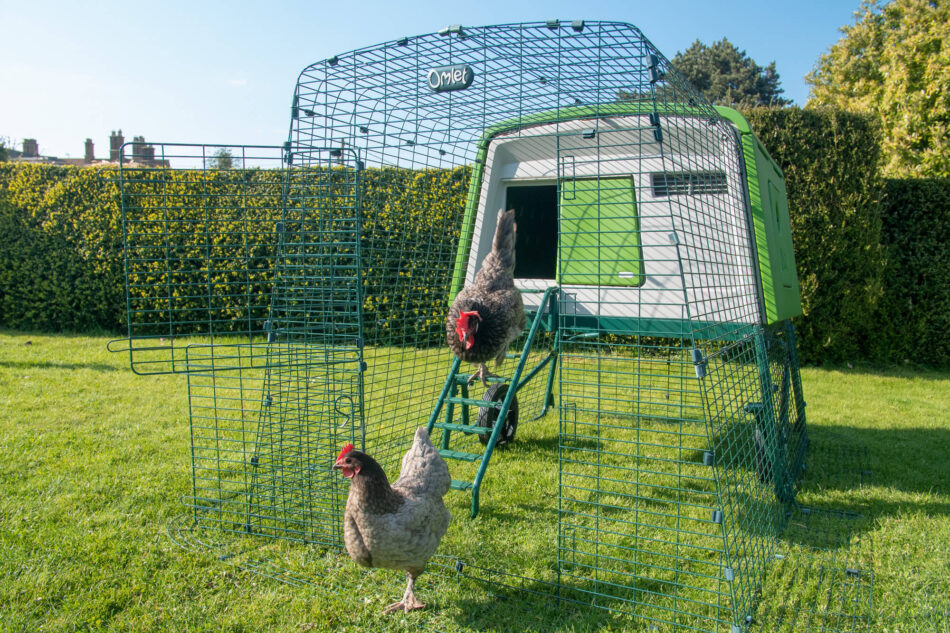
Autodoor and Coop Light
We’re sure you haven’t missed the Automatic Chicken Coop door that can be attached straight onto your Eglu Cube or Walk In Run, but have you seen that you can also attach a coop light to guide your chickens in at night? The light is powered by the control panel of the Autodoor, and will automatically come on 5 minutes before the door closes. As soon as the door has closed for the night, the light turns off.
Run Covers
In high winds and torrential rain, old run covers can take a beating. If you have had your run covers for some time and they are looking a bit worse for wear, it might be a good idea to invest in a new set of covers to ensure your chickens continue to be fully protected from the elements.
Discover our wide range of run covers for all Eglus here.
New hentertainment
We have also introduced new feeders and treat dispensing toys in the last few years, which your chickens are sure to love.
The Caddi Treat Holder is ideal for larger treats, such as fat balls or vegetables from your garden, and hangs in your run to keep food off the ground and prevent mess on the run floor. The Peck Toys are a rewarding, slow release solution for treat-dispensing which your chickens will be entertained by all day. The Pendant hangs from the run, while the Poppy is put into the ground – perfect if your chickens are fully free ranging.
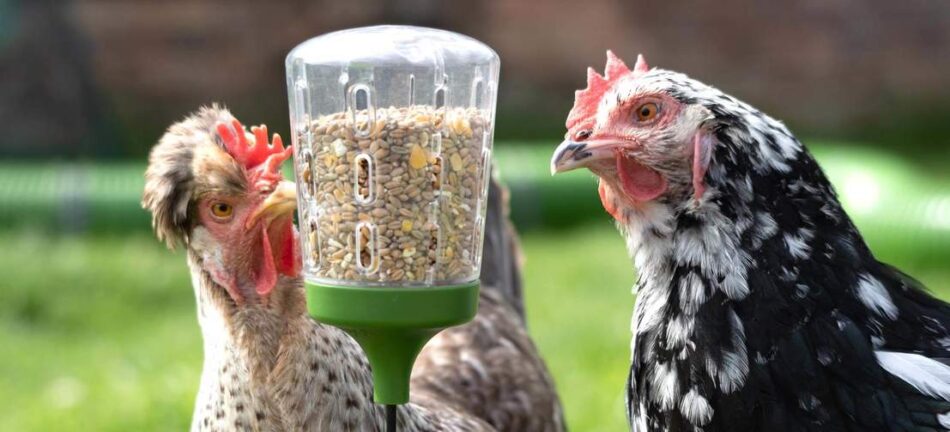
We’re here to help
If you are unsure about the condition of your Eglu or your run, please contact our friendly and knowledgeable Customer Service team. They can give you advice on how to maintain your product, making sure it’s in top condition for many years to come!
This entry was posted in Chickens
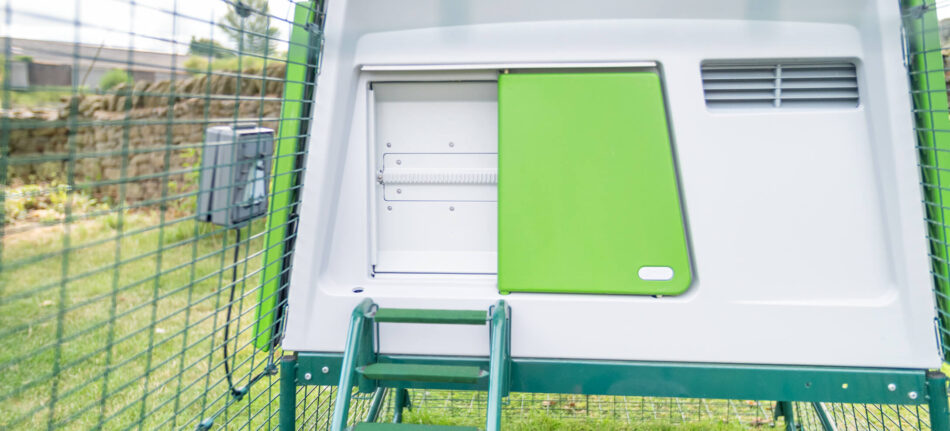
Here at Omlet we often receive calls from aspiring chicken keepers who are seeking chicken keeping advice before getting their first birds. Some of the most popular questions we get asked are, what should I feed my chicken with or how can I protect my chickens from predators? One question that keeps coming up is, do I need to shut the Eglu door at night?
Often people ask us this question because the idea of adding another task to their daily routine might be one of the reasons which puts them off chicken keeping. Much like you wouldn’t like to sleep with your front door open, unfortunately for chicken keepers, nor do your chickens, therefore most nights we would recommend you close the chicken coop door.
But having to close the door doesn’t necessarily mean that it would need to be done by the chicken keeper themselves! Have you ever thought about automatic door system? Well luckily for chicken keepers, Omlet has recently launched a new Autodoor which will solve all of these problems.
Even though our Eglus are specially designed to keep your chickens warm in winter with a unique twin-wall insulation system which works in a similar way to double glazing, leaving the door open overnight would let the cold enter inside which might result in having frozen eggs after a freezing winter night and could make your chickens feel unwell. Therefore, we strongly recommend you use the handle on top of the Eglu and simply lift and twist it to close the door in one convenient motion each evening after having make sure all your flock are inside.
As important as it is to close the door to protect your hens from the cold, it is also important to do it to protect them from potential overnight predator attacks. Most predators would wait for the night to attack your chickens therefore by simply closing the door it would protect your flock from being attacked by predators such as racoons, foxes and coyotes.
Having said how important it is to close your chicken coop overnight we understand that not everyone has the luxury of being at home every night to close the coop door especially for people working late shifts that are often home well after the sun sets. That is why we recently launched an automatic chicken coop door that can be attached directly to any wooden chicken coop, wire or the Omlet Eglu Cube Mk1 and Mk2.
Much like a personal chicken coop concierge, the Autodoor will always make sure your chicken’s coop is securely closed at night even when you’re running late. Whether you decide to use the light or time mode, the Omlet secure and safe Autodoor will either open and close at dawn and dusk or at specific times that you have programmed it to. In addition to being designed to be used in different modes the Autodoor has a unique safety sensor detecting any blockages to prevent your chickens from being injured when they decide to stop half way through the door.
Benefits of the Omlet Automatic Chicken Coop Door:
- Easy to install, no maintenance required
- Operated by light sensor or timer
- Powered by battery
- Works with all wooden chicken coops
- Improves coop security and insulation
- Compatible with the Eglu Cube
- Reliable in all weather conditions
- Built-in safety sensors
- Can be used with any chicken run or mesh
To summarise, closing the coop door is definitely the recommended action for every chicken keeper in order to protect their chickens from the cold and predators however this task can easily be completed by an Autodoor.
Check out the review below to see what one of our Autodoor owners thinks of this new product:
“Thank you Omlet for a wonderful product and great service. The door arrived quickly, very well packaged and my concerns over fitting it were unfounded as I was able to complete the task completely unaided. The door is easy to operate and means my girls are safely tucked up at dusk and I do not have to get up ridiculously early to open the coop and stop them hollering!” – Wendy
Read more reviews

This entry was posted in Chickens
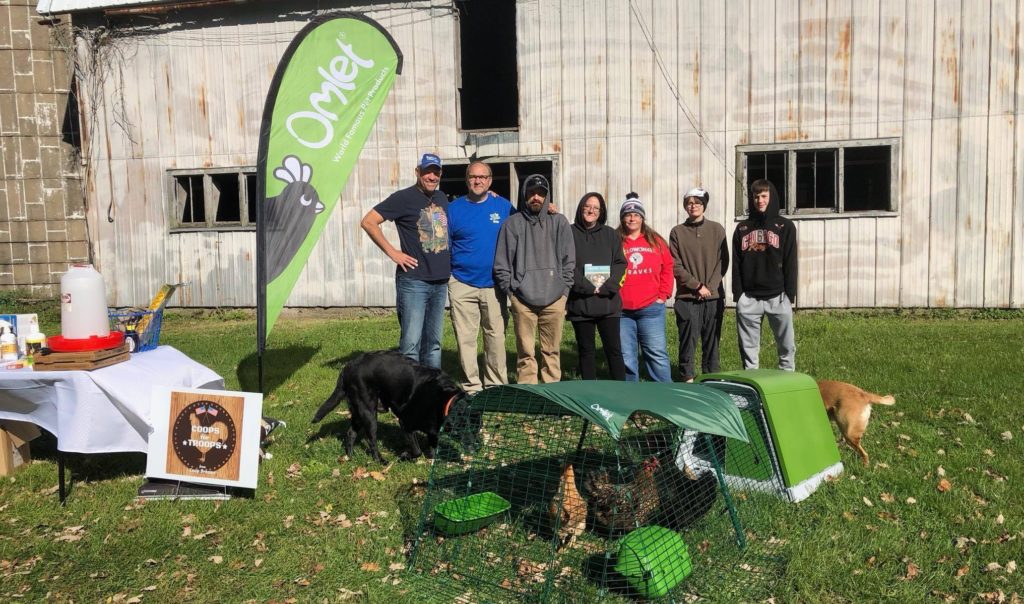
While filming a segment of our television program Coop Dreams, around Austin Texas, we were taken on a field trip to a nursing home that had a chicken coop. Daily the residents would have ‘Chicken time’ where they could hold, pet and interact with the chickens. What we witnessed was incredible. The chickens were amazingly calm and the residents were transformed back in time to when they had raised or experienced a life with chickens. It was super cool to see chickens and residents so comfortable that they both wound up napping while the chickens were on their laps in chairs… And that sparked a curiosity.

The birth of Coops For Troops
Moved by what we experienced, we couldn’t stop talking about it and googling everything around chickens involving support and therapy. We found some amazing information and stories about how chickens can help with:
- Loneliness – We’ve all experienced and been amused by their crazy antics and personalities.
- Stress Relief – Whether it’s the vocalizations or the scratching and pecking there is something very calming about sitting with chickens.
- Depression – A study of the UK organization Henpower shows that – people become less lonely and depressed when caring for the hens.
- Loss of self-worth – There is a sense of purpose one feels when caring for and feeding chickens.
- PTSD – Animals have been shown to be great in relieving the symptoms and elements associated with PTSD.
And after those Google searches we decided to launch Coops For Troops (Coopsfortroops.com) where we present veterans and military families with chickens, supplies and an Omlet chicken coop to help them start their journey into backyard chicken keeping.
Sixteen and counting!!!
Currently we’ve presented 16 Coops For Troops packages and are excited to continue passing on the amazing healing power of chickens.
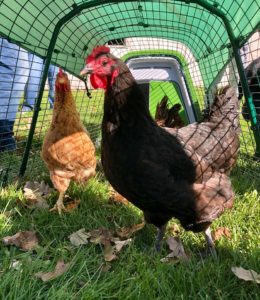
We’ve presented in nine states to date and are sifting through the next round of nominations. Initially it was going to be a one and done event and a small segment in an episode of our Coop Dreams TV show but the response was so great it has spun into its own TV show.
Not only does this allow us to thank more veterans and deliver more coops but the weekly TV audience allows us to share this benefit to others who may be suffering and are in need of some help and relief.
Our viewers and partners help us to continue to pay it forward.
Coops For Troops episodes can be watched, for free, any day and anytime on our webpage by clicking the Video On Demand tab and clicking the Coops For Troops episodes. They can also be seen on our Coop Dreams YouTube channel.
The Results
We all know how chicken math works and that doesn’t change if you’re a veteran, a beginner or an experienced chicken keeper and it is so great to see so many of our Coops For Troops recipients grow and add to their flocks and continue to communicate to us how the addition of chickens has helped in quieting some of the symptoms these incredible individuals now carry.
Sooooooo… On this Veterans Day what can you do? Spread the word and pay it forward. If you know of someone in need maybe mention how the help may be found in these incredible, quirky and amazing animals.
This entry was posted in Chickens
We can learn a lot from chickens — they go to bed early, and know how to snuggle up together to get warm on a cold winter’s night, ready to seize the next day when the sun comes up. But, once we’re down for our long winter’s nap, it’s hard for humans to rise and shine when it means having to trudge out to the coop in the cold. Discover how the Smart Autodoor makes winter easier for you and your chickens when you employ this chicken-life changing piece of technology to be your personal coop concierge.

A Smart Autodoor for any coop
The Smart Autodoor is the perfect solution for all chicken keepers. It attaches to any chicken coop or run, and can be controlled via the control panel or through a mobile app. When connected to WiFi, the Smart Autodoor can be customized, opened, closed, and updated anytime, from anywhere in the world.
Like many ingenious inventions — think wind-up radios, compasses, or steam engines — Omlet’s Smart Autodoor is simple, but effective. This hands-free device has several customizable settings, making it perfect for any schedule, be it human or chicken.
The Smart Autdoor’s open and close schedules can be based on the sun or the clock. The daylight setting adheres to a schedule based on how much daylight is available, keeping your flock in their routine even when the time changes in preparation for winter. If you prefer to have more control over your coop, the time setting can be programmed to open and close the coop door at the times of your choosing. The manual setting enables you to open and close the door at the push of a button on the app or control panel, or by speaking a request to your Alexa or Google Home device.
Attaching the Smart Autodoor
The Smart Autodoor was made to be the perfect companion to our larger chicken coops. If your flock already lives in an Eglu Cube or Eglu Pro, installation is quick and simple. But, fitting the Smart Autodoor to traditional chicken wire, Omlet’s chicken run wire, or wooden chicken coops is also simple thanks to the corresponding attachment kits.
Once installed, the control panel is powered with batteries or through the direct wire connection. The integrated light censors of the control panel are intuitive, ensuring that passing headlights or sudden cloud coverage doesn’t trigger the Smart Autodoor to open or close when using the daylight setting. Positioning your control panel on the side of the coop with a mounting bracket will allow constant access to ambient lighting.
The optional coop light helps your hens head to bed on time. By installing the light around the roosting area of your coop, your flock will have a night light to beckon them to bed. The coop light will come on 5 minutes before the Smart Autodoor closes by default, but this time can be adjusted through the app to accommodate hens that may tend to stay out past their roost-time.
Why is the Smart Autodoor better in the winter?
Aside from the warmer mornings in bed, or sparing yourself a chilly trek to the coop with a few taps on your mobile device, the Smart Autodoor offers practical benefits for your flock in the winter. The seal of the Smart Autodoor further insulates our chicken coops by maintaining a draft-free environment. And, the control panel and Smart Autodoor mechanism has been tested and proven to perform in temperatures below 0 degrees Fahrenheit.
The horizontally-opening mechanism of the Smart Autodoor is strong, designed to reliably perform in all weather conditions and to protect against predators. Instead of a string and pulley system, the components of the Smart Autodoor are nearly impossible for predators to pry open. But even with its strength, our automatic coop door has a delicate door sensor that ensures that no part of a hen is closed in the door. If the sensors detect an obstruction, the door will stop and reverse its path, and will try again after a few minutes.
Between holiday travels and the fluctuating daylight hours, keeping your flock safe and on schedule has never been easier. Like a true coop concierge, the Smart Autodoor eliminates the need for you to brave the cold outside of your cozy bed to let your flock out of their coop, or venture out in the freezing temperatures to close your hens in their house for the night.
Omlet and your flock
We’re here to make winter a more enjoyable experience for you and your flock. From our Smart Autodoor to our insulated chicken coops and chicken coop and run weather protection, we have everything you need to keep your chickens safe, warm, and covered throughout the entire season. Enjoy the warmer hours of the day with your flock, while our ingenious products take care of them during the cold. So snuggle up with your loved ones this winter, knowing Omlet is helping your flock do the same in their setup.
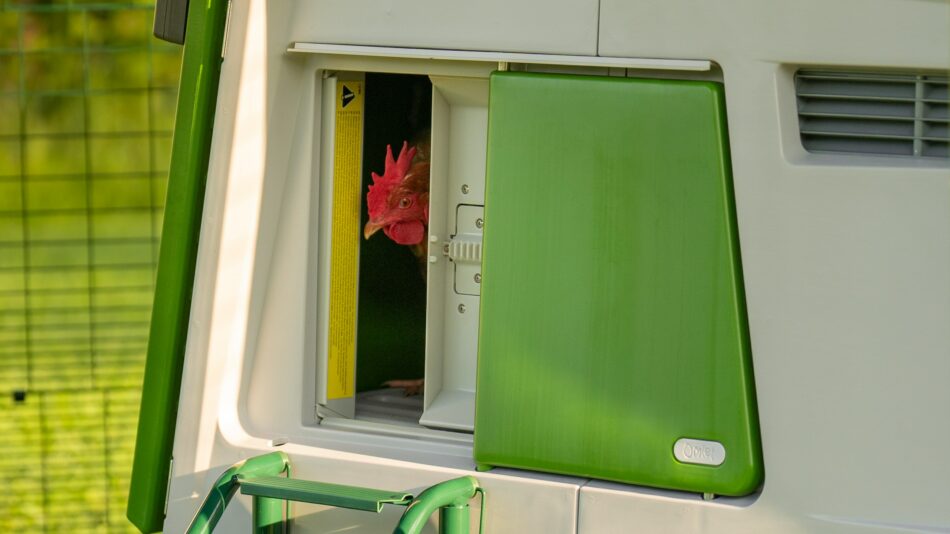

This entry was posted in Chickens
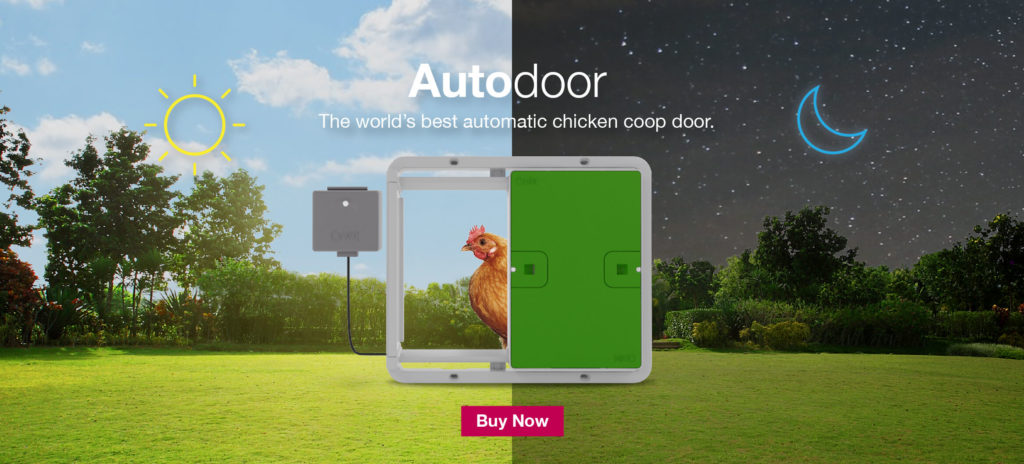
Did you know that over 60% of chicken keepers aren’t getting enough sleep?! Omlet has the solution as they launch the New Automatic Chicken Coop Door.
In the last decade chicken keeping has become a hit with families wanting a slice of the good life, propelling hens into the top ten list of pets. The reasons are clear: a supply of fresh eggs that’s the envy of your friends as well as teaching children important lessons of where their food comes from suggests that chickens really are the ultimate pet.
However, a recent survey found that over 60% of chicken keepers wish they could spend longer in bed in the mornings with many admitting they would be willing to pay up to $400 for a solution that could prolong their lazy mornings in bed! 1 in 6 couples even admitted to regularly arguing about who should let the chickens out. What will save the country’s chicken keepers from tiredness and possibly even divorce?

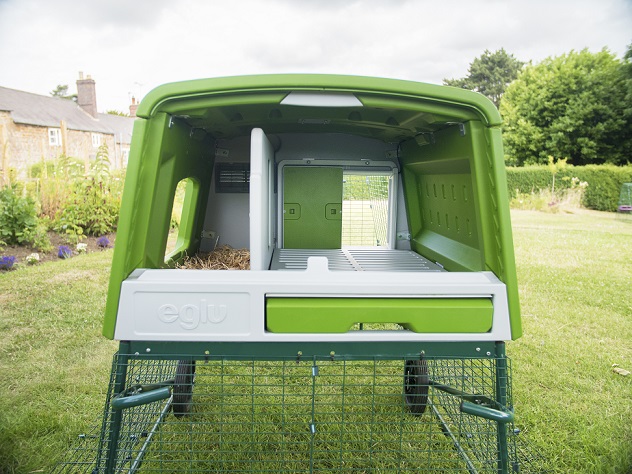
Introducing the brilliant new Automatic Chicken Coop door opener from Omlet. Designed to work with the best-selling Eglu Cube as well as any wooden chicken coop. Omlet’s Automatic Chicken Coop Door Opener is battery powered and combines both a timer and a light sensor, giving you the ultimate flexibility and control.
Omlet’s Head of Product Design, Simon Nicholls, said: “We know our customers love their chickens and always want the best for them, that’s why we designed the Autodoor so that the hens could get up when they want, which can be quite early in the summer. It was also important to ensure that it works as well at closing the coop at night and in all weather conditions too, so we carried out extensive testing in several different countries over 2 years to perfect the design.”
The unique integrated frame and door design comes with everything you need to attach it to your chicken house or run and has been tested to work down to -20 deg C. Like a personal chicken coop concierge, the Autodoor will always make sure your chicken’s coop is securely closed at night even when you’re running late.
Sharon Burton, who has kept hens for 4 years in Oxford, believes the Autodoor has even saved her marriage! “There’s nothing I wouldn’t do for my chickens. I buy them the best food, I sprinkle dried flowers in their nest box to keep it fresh, but I always felt guilty if I didn’t hop straight out of bed at the crack of dawn to let them out and whenever I asked my husband Paul to do it he would pretend to be asleep! When Omlet asked me to test the Autodoor I was delighted, it’s saved my marriage!”
Omlet’s new Automatic Chicken Coop door opener is available now to order! Prices starting from $189.
This entry was posted in Chickens







































 Unfortunately, bullying amongst chickens happens, and isn’t actually too uncommon of a problem. Chickens naturally create a pecking order, whereby the flock will establish themselves in a social hierarchy of strongest to weakest chicken. However, if aggressive behavior continues after the head rooster, or the dominant hen in their absence, has found their way to the top of the ladder, you may be dealing with a bully. Common signs are missing feathers from a chicken’s back, unusual weight loss, reduced egg production, or blood from where the victim has been pecked, all of which could lead to a chicken/s refusing to go into their coop at night.
Unfortunately, bullying amongst chickens happens, and isn’t actually too uncommon of a problem. Chickens naturally create a pecking order, whereby the flock will establish themselves in a social hierarchy of strongest to weakest chicken. However, if aggressive behavior continues after the head rooster, or the dominant hen in their absence, has found their way to the top of the ladder, you may be dealing with a bully. Common signs are missing feathers from a chicken’s back, unusual weight loss, reduced egg production, or blood from where the victim has been pecked, all of which could lead to a chicken/s refusing to go into their coop at night.











